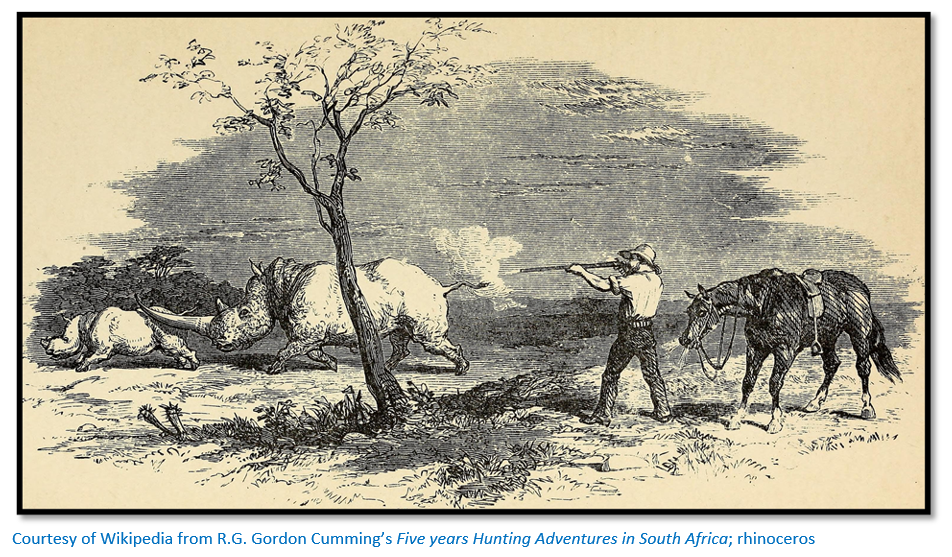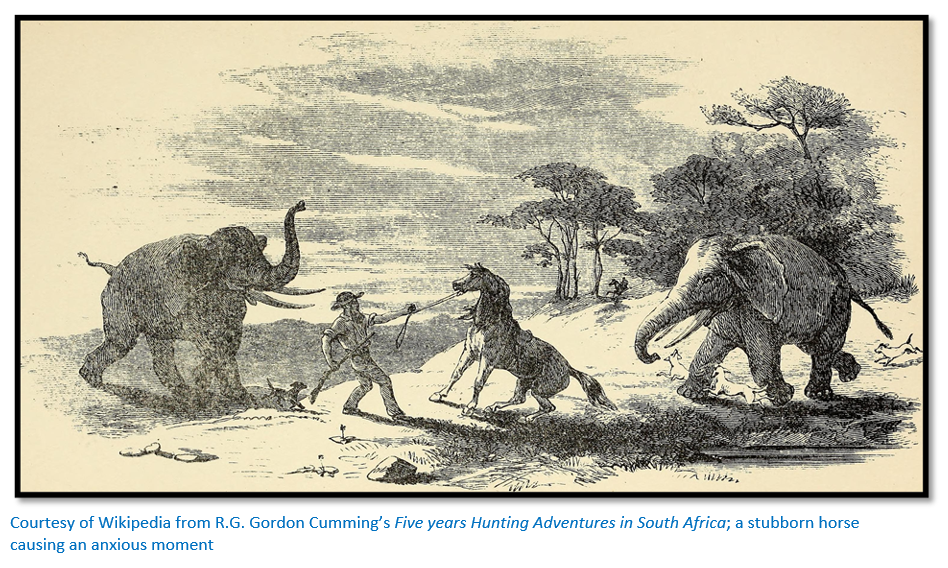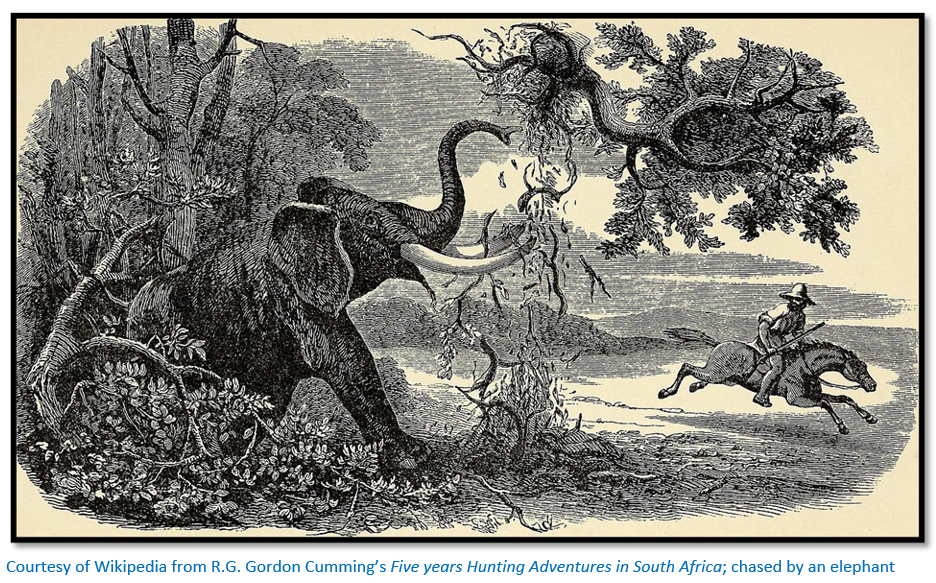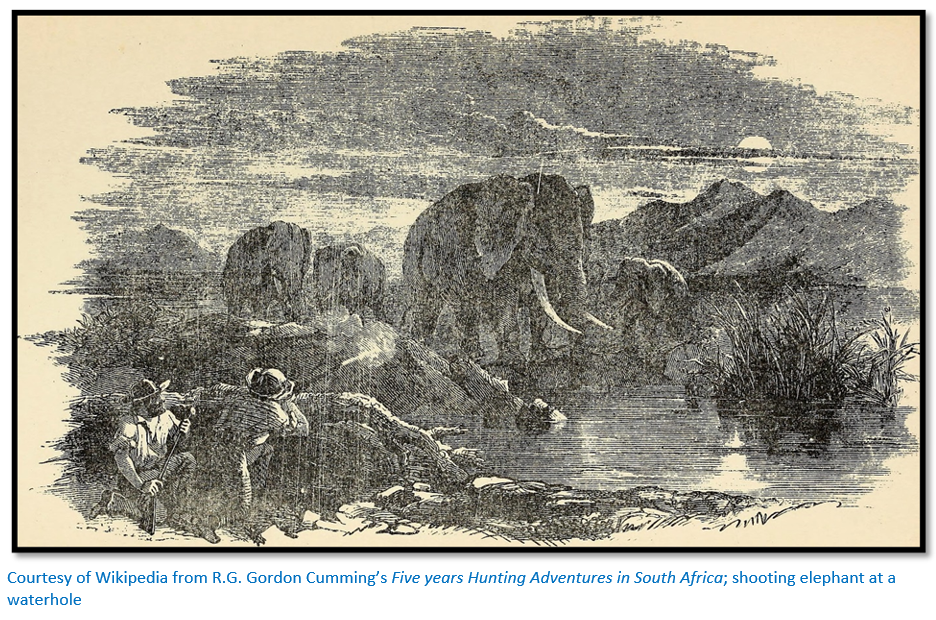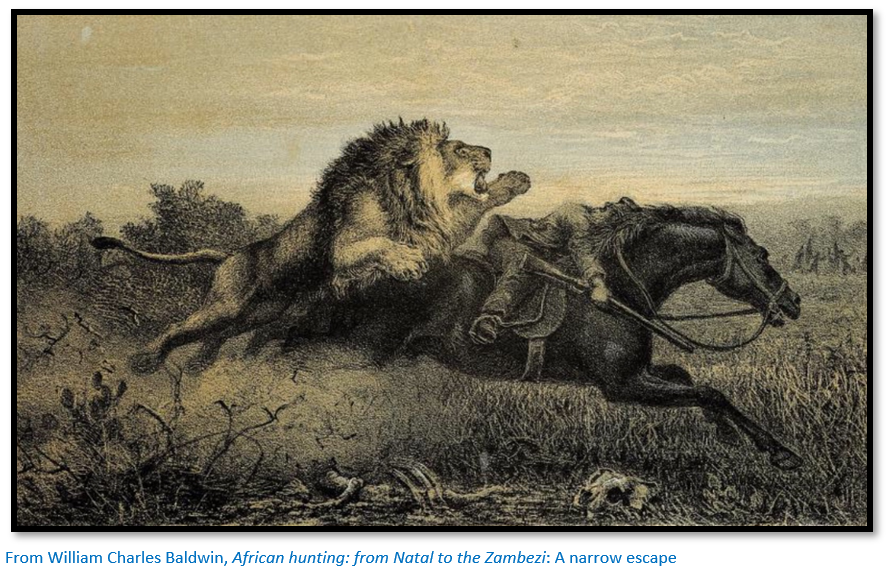Big game hunters in present-day Zimbabwe until 1880
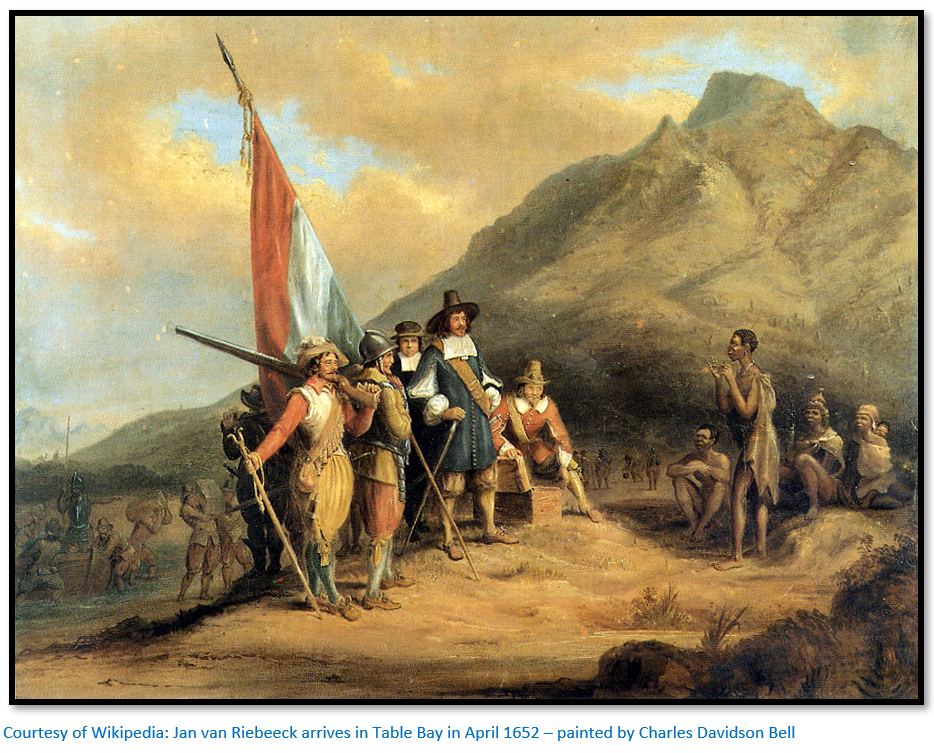
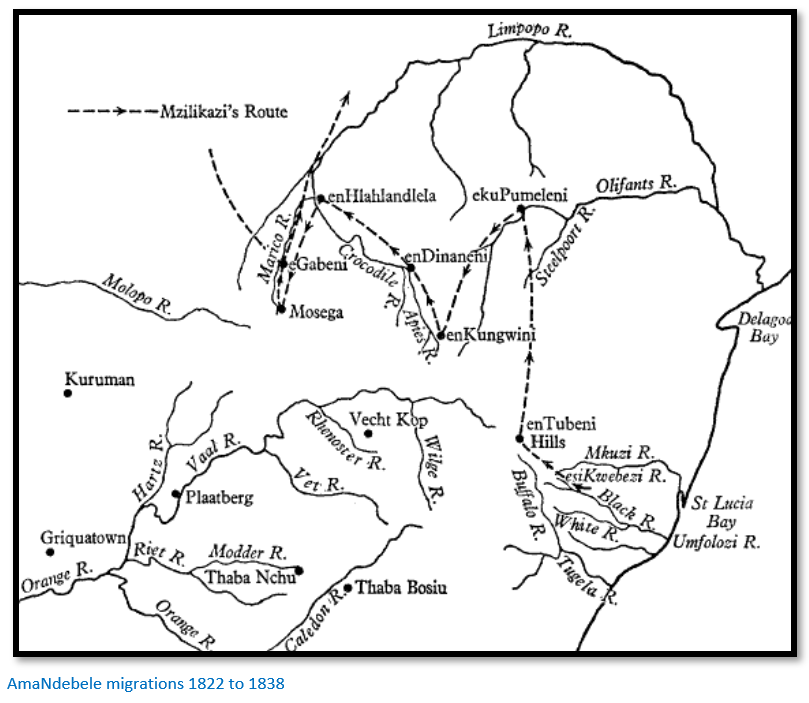
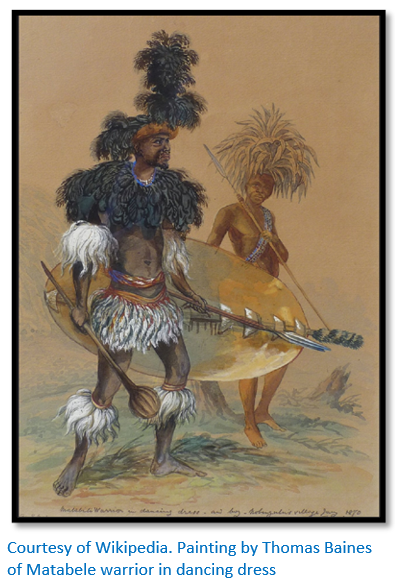
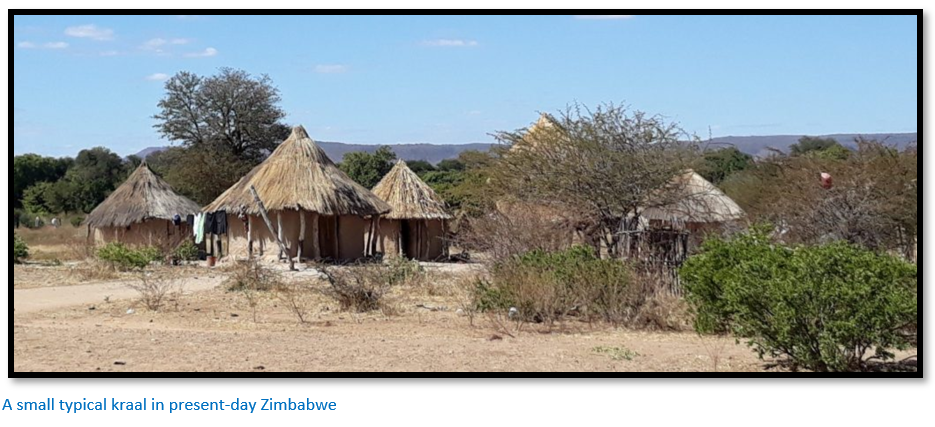
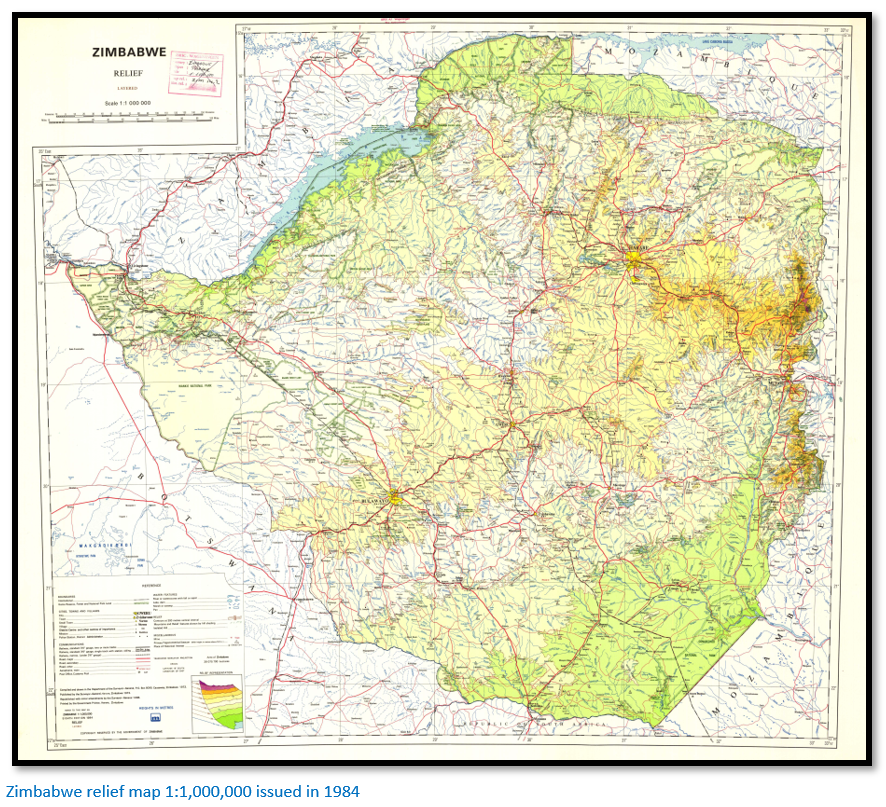

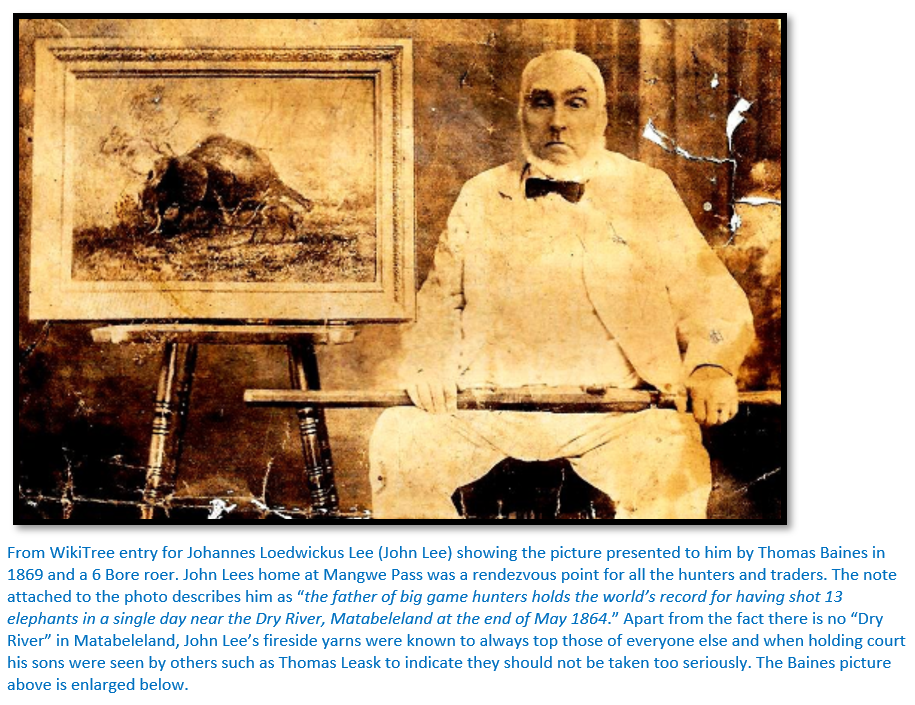
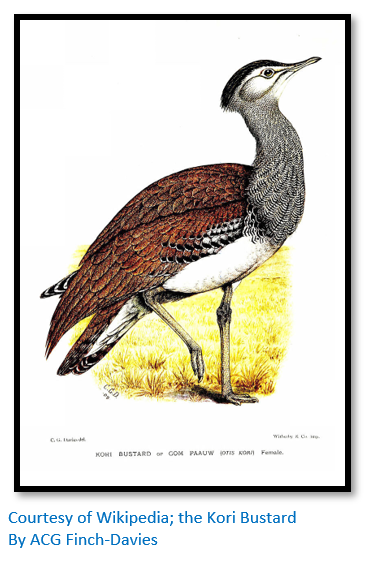
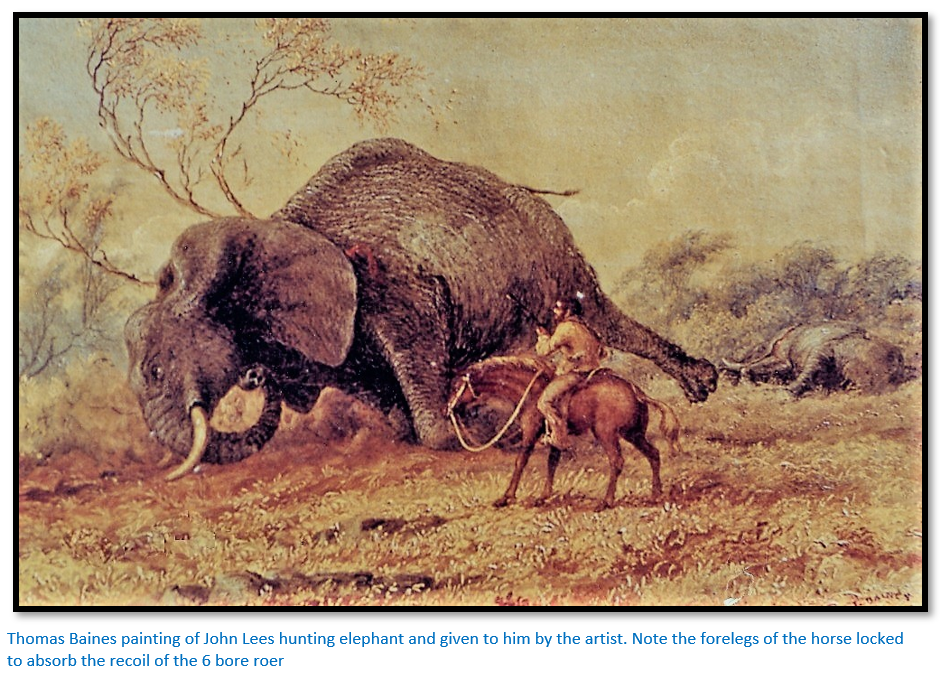

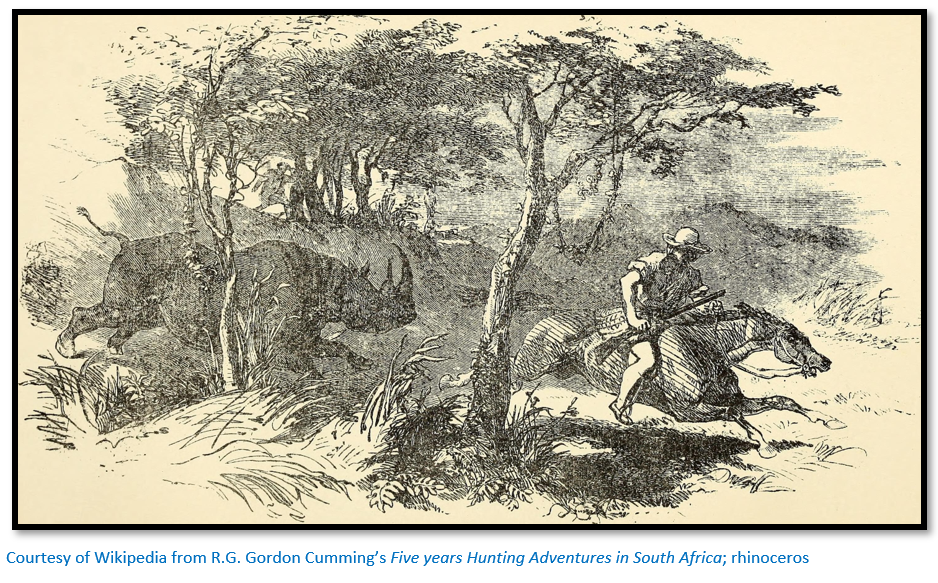
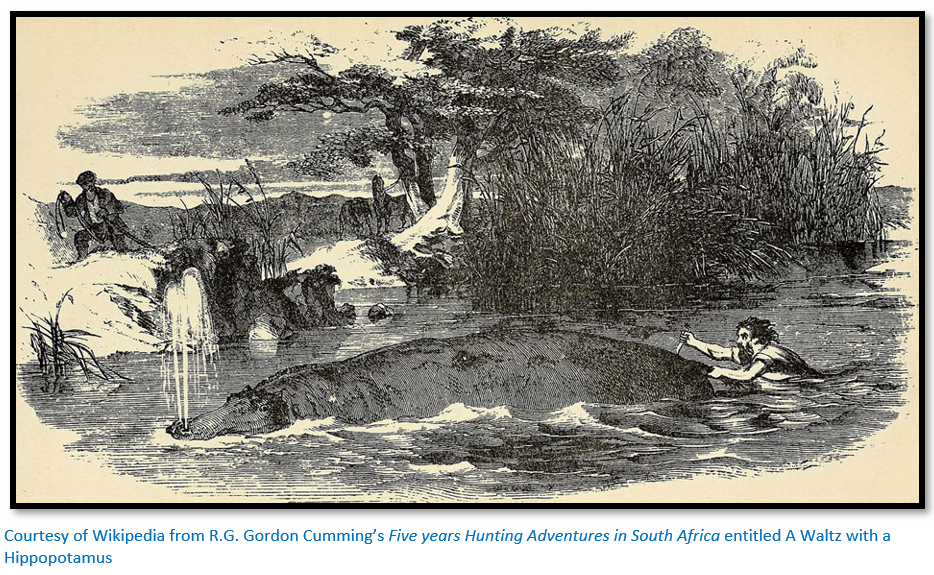
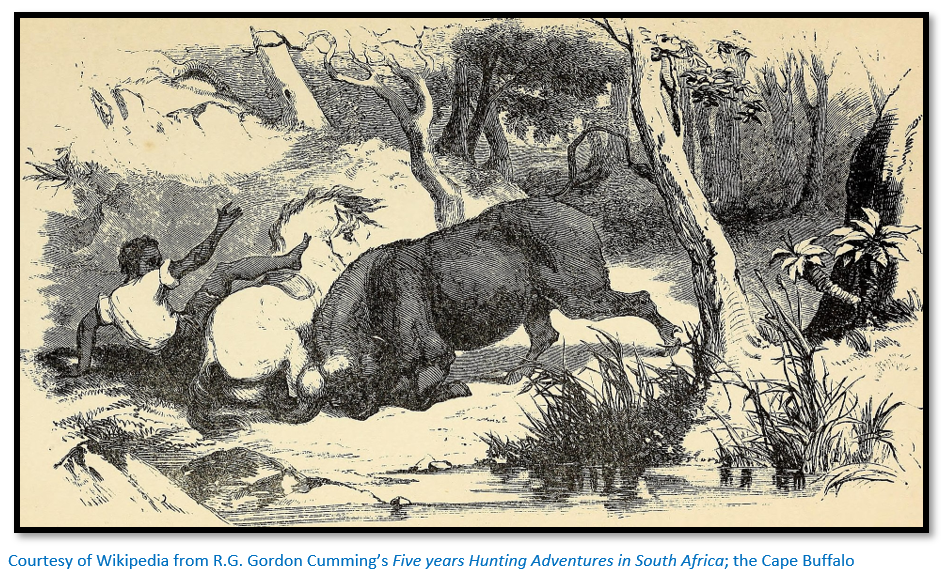
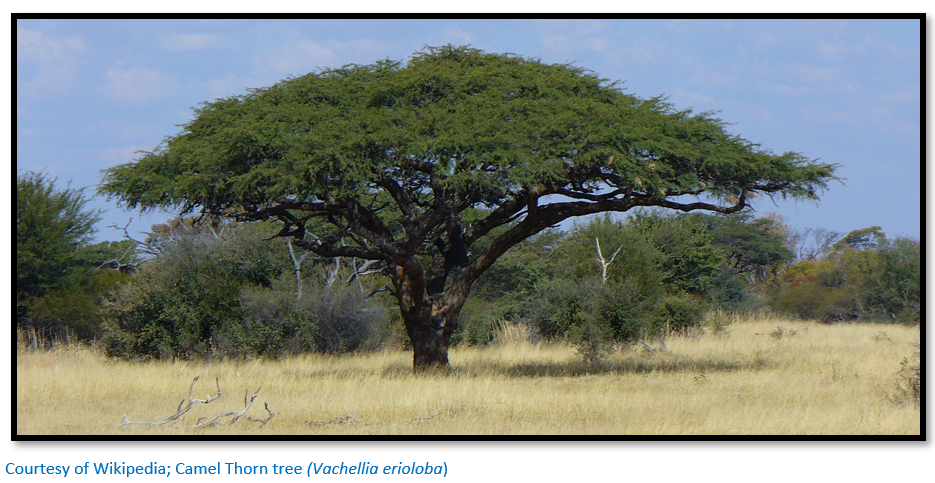
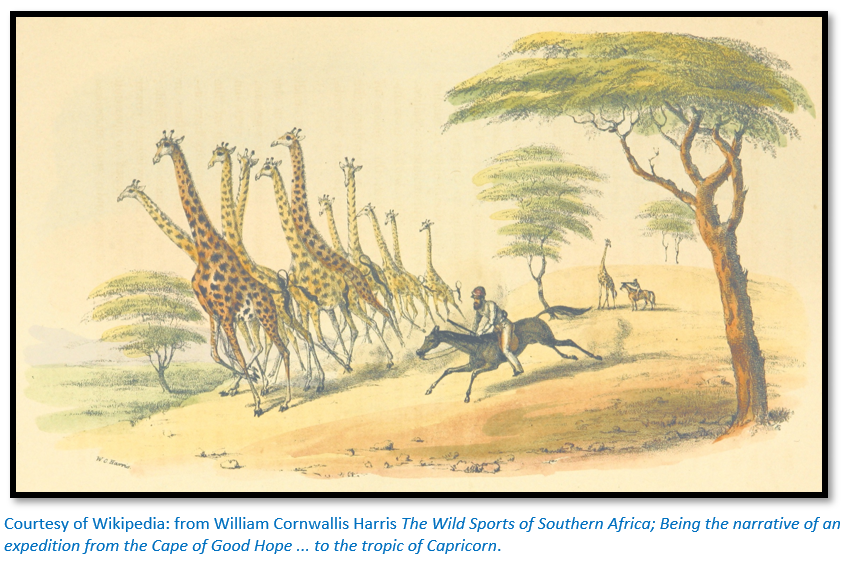
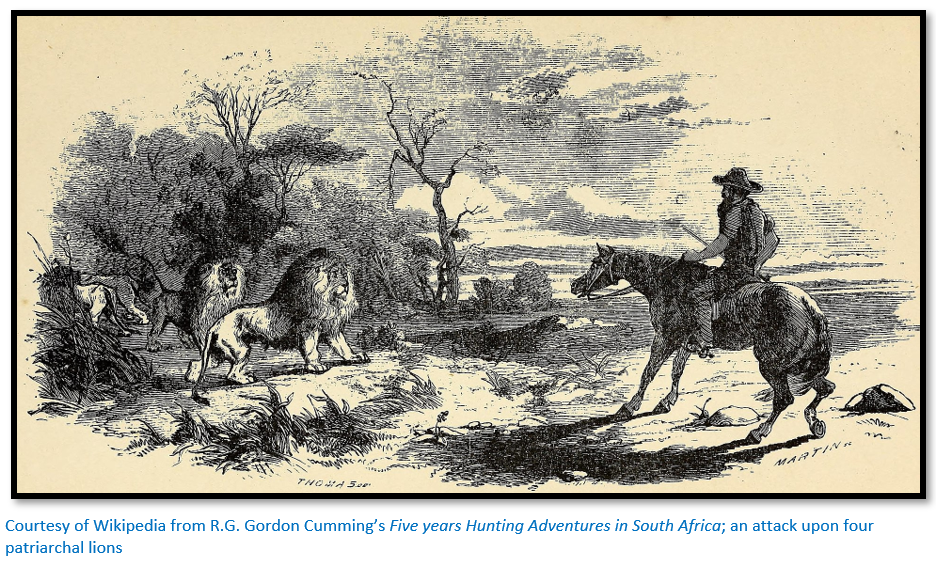
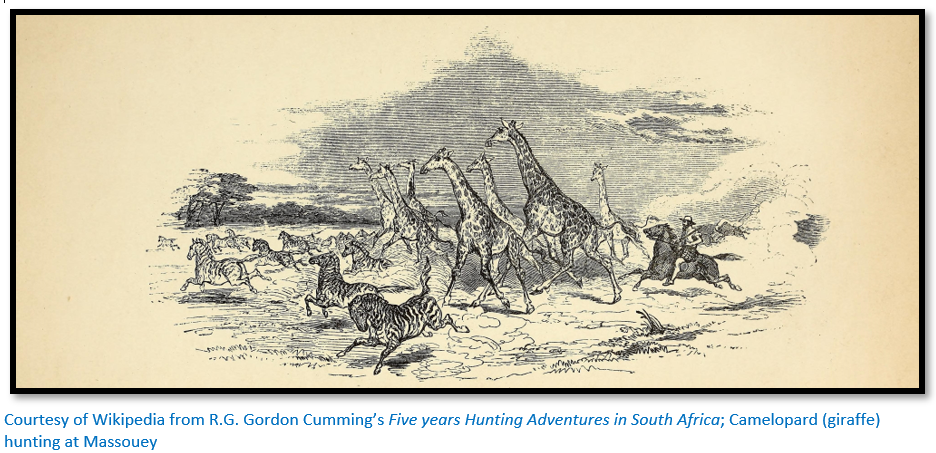
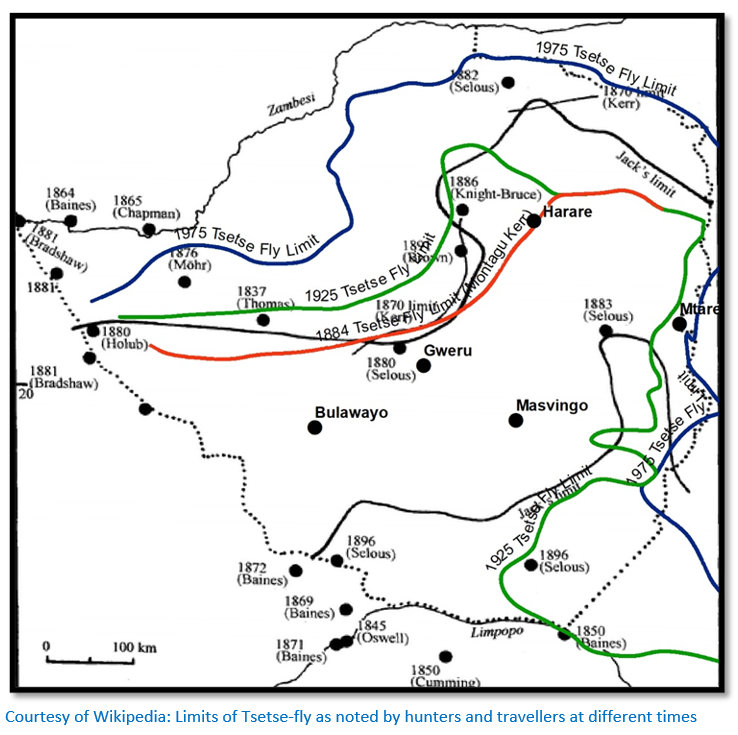
| Hunters in Matabeleland and Mashonaland before 1880 | ||
| Years | Name | Details |
| 1876-1889 | Afrika, Jan | Mixed race Jewish and Griqua, he worked for Westbeech in 1877 and worked as an elephant hunter from Pandamatenga and in 1884 was badly mauled and fought and killed a lion with his knife. A big man and good hunter he died in March 1889 |
| 1875-1895 | Afrika, Klaas | The son of Jan Afrika who started hunting at 14 years old and became one of Westbeech's hunters and lived his entire life in the Zambesia. Like his father was mauled by a leopard at Pandamatenga in 1884 which he killed with a knife. Living at Sesheke in 1895 and hunting for Westbeech and said to have married one of Lobengula's daughters. Killed at least 200 elephant and 20 lions. |
| 1875-1878 | Anderson, 'Sandy' | Hunted at the Makgadikgadi salt pans and trekked to the Falls in 1875 and made another trip in 1877 hunted at Deka and the Nata river |
| 1853-1860 | Arend, Joseph | Griqua hunter hunted in Bechuanaland and was at the Falls in August 1860 |
| 1865-1878 | Baldwin | Brother of W.C. Baldwin hunted and traded in Matabeleland in 1866 and was hurt falling from a horse in the Marico district in 1867. By 1875 he was drinking heavily and had a bad bout of fever at the Wegdraai. Died of fever at Pandamatenga about November 1878 |
| 1853-1860 | Baldwin, William Charles | Baldwin first hunted in Zululand with a party of 11 led by 'Elephant' White of whom 7 died of fever. He started for Matabeleland in 1857 but Mzilikazi refused permission to hunt and he returned to Swartz's farm at Marico in January 1858. He outfitted again and killed his first elephant at Lake Ngami in June 1858. Travelled with Alington and Woodcock in May 1859 taking the Western Old Lake Road to the Botletle river. They only killed 18 elephants but traded 5,000 lbs of ivory. In May 1860 he left Shoshong and became the second European to visit the Victoria Falls where he met D & C Livingstone and Dr Kirk and stayed and hunted until September. Returned to Shoshong in November - he and his 3 native hunters killed 61 elephants. Left South Africa in 1861; a good horseman, but not a great hunter. Wrote African Hunting and Adventure from Natal to the Zambesi. |
| 1875-1895 | Frederick Hugh Barber | Left Kimberley to hunt and trade in March 1875 with Frank joining the Kirton's and D. Jacobs and trekking to Gerufa pan where they hunted before going to Pandamatenga and the Falls where they met Dean and Clarkson and hunted on the Westbeech Road before returning to Kimberley in January 1876. Fred and Henry Barber left Kimberley in April 1877 and travelled to Gubulawayo for permission to hunt before taking on Lee's road to the Linkwasa Valley and Dett. Henry was badly hurt by a buffalo and was nursed by his brother. They killed 51 elephant and returned to Gubulawayo for the Inxwala before returning to Kimberley in February 1878. Thereafter mined at Barberton and then at Johannesburg and hunted in Namibia, Mozambique, the Transvaal Swaziland and Basutoland. See the article Frederick 'Freddy' Hugh Barber hunter, trader, artist, visited the Victoria Falls in 1875 and Matabeleland in 1877 on the website. |
| 1872-1895 | Henry Barber | Hunted in the Waterberg and Zoutpansberg in 1872-3 where they captured ostriches and Henry killed his first lion. In 1890 hunted in the Transvaal lowveld; in 1894 at Delagoa Bay and in 1895 in the Kalahari. Farmed in Kenya until his death in 1920 |
| 1876-1877 | Bell, C | Made an unsuccessful hunting and trading trip to the Zambesi and returned with Selous to Kimberley |
| 1866-1891 | Beningfield, Reuben | Initially traded in Gaza Province, Mozambique and visited Soshangana visiting Mt Selinda in present-day Zimbabwe. A good elephant hunter he employed many African hunters in the Save river valley. Secured a concession with Chief Mutasa which was revoked and replaced when Selous negotiated a new concession for the British South Africa Company in 1891 |
| 1877 | Bezuidenhoudt | Hunted with John Lee and sons and Van Rooyen in the Linkwasa Valley in June 1877 |
| 1870-1871 | Blanch, Gustavus | Hunted with W. Finaughty and the Jennings brothers near Tati in 1870 on the Semokwe and Shashani rivers |
| 1871-1887 | Blockley, George | Employed at Pandamatenga from 1871 and was continually resident for the next 16 years longer than any other European. Travelled with Westbeech to the Barotse Valley in 1872-3, saw Oates in 1874, took Holub in 1875 to Sesheke. Travelled to Wankie's town with Robertson and Mackenna in September 1877 and met the Jesuit missionaries in June 1880 taking them to the Falls. Guided the Jesuits to Wankie's town and the Zambesi river. Returned from Lesuma in Barotseland to Pandamatenga with fever in June 1881 and met the missionary Arnot in August. On Arnot's return from Sesheke nursed him at Pandamatenga. Managed Westbeech's store at Lesuma in 1884 and returned to Pandamatenga in 1886 and assisted Bethell and Ayrton in June. Died in August 1887. Called 'Little George' to distinguish him from Westbeech |
| 1860-1870 | Bokkis | A Griqua, he was W.C. Baldwin's transport manager on his trip to the Falls and stayed behind to hunt elephant re-joining Baldwin in Natal in 1861 with much ivory. Came to Tati in April 1869 with Coward and was hired by Mohr when his contract expired taking them to the Zambesi Valley and returning with Mohr to Natal in 1870 |
| 1877 | Bray | He and George Wood were refused permission by Lobengula to hunt in Mashonaland and went to the Zambesi returning with Wiltshire, Palmer, Gordon and Fry in December |
| 1871-1877 | Browne, W.A. | Entered Matabeleland in 1871 with Tainton and Cross to hunt and trade and continued their partnership until 1880. Travelled with F. Barber and Frank from Kimberley and arrived in Gubulawayo in June 1875; Lobengula gave permission to hunt in the Zambesi valley and were at Nwasha pan by 20 July. Walked to the Falls with Cross, Anderson, Barber, Frank and Wilkinson. Refused permission to enter Barotseland was back in Gubulawayo in December 1877. Nicknamed 'Zambesi' Browne |
| 1868-1878 | Byles (or Biles) Henry | First in Matabeleland in 1868 with partners Zietsman & Mayer where hunted elephant on the Gwai river to Shangani confluence. Hunting with Wood, McMaster and Firmin in 1869 when Firmin killed on the Ramaquabane river. Met Leask at Summamolisha in August 1868. During summer months lived in their wagons at Mangwe where he and Meyer repaired guns and wagons. Accompanied Baines, Lee and King to see Lobengula in Jan 1870. Byles, Leask, Maloney and Van der Berg left Gubulawayo in April 1870 and reached the Mupfure river in early May and joined William Hartley and O'Donnell. Last two died at Hartley Hills and all were ill except Byles. Returned to Mangwe in August 1870. Another hunting trip to the Manyame river returning to Lee's in September 1871. Hunted around the Semokwe river with Herbst, P. Lee and De Schmidt's and Jennings brothers before hunted on the Shashi. Then with Baines to the Macloutsie and Limpopo rivers and reached Pretoria in mid-November. At the Eerstelling goldfields in 1871 and Lydenberg goldfields in 1872 where he hunted game for the miners. In 1873 went to the Zambesi with Schinderhutte and Garland and at Pandamatenga in September. At Gubulawayo from April to August 1875 with Petersen and Fairbairn and on the Gwai river returning to Inyati in October. At Pandamatenga in August 1877 for two months and was at John Lee's in January 1878. |
| 1876-1876 | Cameron W. | At Gubulawayo in 1876 and 1877; spoke isindebele and knew Matabeleland well; no other details |
| 1860-1866 | Chapman, Edward G. | Traded in Bechuanaland and Matabeleland buying ivory and ostrich feathers from T.M. Thomas. Fourth trip to Matabeleland with his partner W.C. Francis in 1864 at Zwangendaba kraal for two months buying 5,000 lbs of ivory. Hunted elephant at the Ramaquabane river in October 1864. Travelled with Finaughty to Gubulawayo in March 1865 and again in 1866 reaching Gubulawayo in June / July. Quit hunting and trading in the interior in 1866 and lived at Kuruman |
| 1849-1863 | Chapman, James | Started trading from Potchefstroom in 1849 with short hunting trips to the Transvaal. In 1850 and 1851 visited the Marico district. Left his store and went with Jan de Vaal, Wirsing, Greyling and Viljoen in May 1852 and shot his first elephant beyond the Notwani river before reaching Shoshong. Arrived at Botletle river in July and hunted elephant with great success until Sekhome sent tribesmen to stop them. Planned a trip east to the Nata river but local tribesmen reported an untrue rumour that an amaNdebele impi was approaching. Reached Shoshong late September 1852. Chapman sold his store and was back in Marico district in Jan 1853. Trekked north avoiding Shoshong and were at Chobe river by August hunting elephant. Delivered goods from Moffat for D.. Livingstone though they did not meet him and Chapman visited the Linyati Valley. The boatmen refused to take him to the Victoria Falls because of amaNdebele raiding which might have otherwise made him the first European to visit. Had a difficult return journey from the Mababe flat to Lake Ngami with difficulties from tribesmen and fever. Thompson came to his rescue and returned Kuruman by Feb 1854 where the Moffat's nursed him back to health. Settled accounts with Thompson and partnered with Edwards, but decided to split to obtain more ivory; Edwards went to Matabeleland with Moffat, Chapman to Lake Ngami. Reached Lake Ngami by July but left as there were no elephants and went via the northern edge of the Makgadikgadi pan to the Nata river by September. Hunted with his after rider Mahura on the Shashi and Matengwe rivers, but warned of amaNdebele incursions went down the Western Old Lake Road to Shoshong by October. Went north with Edwards on the Ngami road again in November to the Chobe to get news of D. Livingstone. Edwards caught fever, Chapman went to Lake Ngami and boated on the lake with Green. Decided to find a route out to the west coast and were at Walvis Bay in October 1854 but only reached Cape Town in early March 1855. Chapman and Edwards returned to Walvis Bay in 1856 and crossed the Kalahari to Ngami, but the population were starving so they hunted in the vicinity. Chapman returned to Cape Town via Bechuanaland, Edwards stayed. Chapman was back at Ngami in 1857 to find Edwards had left and he returned to Cape Town. In May 1859 Chapman took the Polson brothers, Kenny and Cator to hunt on the Zambesi trekking from Walvis Bay. They reached Ngami in August, but his servants refused to go further, so he stayed and hunted, returning to Walvis Bay by January 1860. He made another journey to the Zambesi with Baines from December 1860 to July 1863. This trip ruined his health and finances and he lived in some poverty in Cape Town for the next four years moving to the diamond fields on 1870 where he died in February 1872 aged 41 years. South Africa's greatest explorer, a good linguist in native languages and methodical collector. |
| 1867-1874 | Cigar | A Griqua hunter once a jockey at Grahamstown first went into the interior with the Jennings party as a driver in 1867. W. Finaughty took him to shoot on halves at the Semokwe in 1869, but he was so terrified of elephants that Finaughty put him to hunting rhinos instead. By 1872 he was over his fear of elephants and introduced F.C. Selous to elephant hunting in the tsetse-fly areas. He traded for some years at Gubulawayo and left Matabeleland in 1874 and in 1895 was living in poverty near Zeerust. |
| 1875-1879 | Clarkson, Matthew | Horn's partner in 1875 when he first came to Matabeleland. Walked with Deans via the Gwai valley to the Falls in August 1875 and met Cross, Browne, Anderson, Barber, Frank and Wilkinson and returned to Pandamatenga. Ran a store with Goulden in Gubulawayo in 1877-78. Left for Mashonaland with Wood and Cross in June 1878 to the Mupfure river and killed about 40 elephant. Joined in September by Selous and Goulden operating from the Mupfure and Biri rivers returning to Inyati in December 1878. Planned to go hunting on the Mababe flats with Collison, French, Selous, Miller and Sell but was struck by lightning in April 1879 whilst talking to Collinson on his wagon and died. |
| 1877-1885 | Collison, Henry | In the Zambesi valley and Pandamatenga in September 1877, hunted with French, Selous Miller and Sell at the Mababe in 1879 (Clarkson killed by lightning at Klerksdorp) and French died from thirst chasing a wounded elephant in September 1879. Left in December. Collison in Matabeleland in May 1880 with J.S. Jameson and Dr Crook and accompanied them and Selous to Mashonaland. In Kimberley at the end of 1881 after another trip to Mashonaland and joined Selous again in Mashonaland during the winter of 1885 |
| 1875 | Cowley, Richard | Accompanied MacLeod and Fairlie to the Zambesi; died of fever at Pandamatenga on 19 December 1875 |
| 1871-1880 | Cross, Alfred | Went to Matabeleland with his uncle Tainton and Browne in 1871 staying as their partner until 1880. Assisted at Mrs Palmer's funeral at Hope Fountain in March 1875, trekked to the Zambesi and the Falls with Browne. When one of his servants robbed his wagon he was pursued and captured with the help of F. Barber and Wilkinson and taken back to Pandamatenga for a flogging. Hunted in Mashonaland with Clarkson, Wood, Selous and Goulden in 1878 |
| 1872-1873 | Dawnay, the Hon Guy Cuthbert | Dawnay and Moore left Durban in December 1872, 17 of their 32 oxen died at Bushman river. They were at Pretoria by March 1873 and visited Henry Hartley at Thorndale and were at Shoshong in April where they met Westbeech, Clarke, Gordon and Humphrey and then at Tati in May and Lobengula 'gave them the road.' They trekked through Mangwe Pass in early June and found Piet Jacobs at the Nata river who provided a guide for the Westbeech Road. They reached Tamasanka vlei and then Pandamatenga by 5 August from where they walked to the Falls. In August they shot at The Berg where Dawnay killed 13 elephants, leaving Pandamatenga on 3 September. Reached Tati by 18 October 1873 where they took out £900 of gold for Nelson meeting the Garden brothers at the Limpopo and Buckley and Gilchrist at the Marico river. |
| 1875-1879 | Deans, Alexander | Trader in Gubulawayo, hunted with Lobengula and Tainton in March / April 1875. Accompanied Clarkson to the Zambesi and the Falls July - September 1875. Helped Finaughty bring in two cannons in December 1876 and traded with Matabeleland from Shoshong from March 1879 to at least October 1888 when he visited Gubulawayo |
| 1869-1875 | De Smidt | Lived an itinerant life in Matabeleland and Zambesi Valley in the 1870's. Farmed in the Marico district and hunted elephant on the Tati river in 1869-70 joining W. Finaughty at his camp on the lower Shashani in May / June 1870. Camped with other Boers on the Ramaquabane in January 1873 when six people died from fever. Left Mangwe with Piet Jacobs and met Dawnay and Moore at Nwasha pan in June 1873 and was at the Umpakwe river above Tati in September 1873. Hunted to the south with Frank Oates in February 1874. Family of De Smidt's at Hendrik's Pan in July 1875. |
| 1872-1882 | Dorehill, George | Journeyed with Selous and Sadlier from Kimberley in March 1872 and worked for Kisch at Gubulawayo and went to Mashonaland in November 1872 to trade and returned in December with Selous, Mandy and Cigar. Rode from the Ingwesi river with Frank Oates in July 1874 and trekked with Schinderhutte and Oates from Tati along the Westbeech road in November meeting Selous and Wood at Matengwe drift on 1 December. They persuaded Dorehill not to go to the Zambesi (Frank Oates continued and died on the return journey) and returned to Tati. I Gubulawayo in February 1875 and left Matabeleland with Palmer. At Shoshong met McLeod and Fairlie to the Falls and Barotseland returning to Shoshong in March 1875. Trekked with Selous to Tati by August 1875 and then Gubulawayo and with Grandy and Horner joined Westbeech's party to the Zambesi. All three were ill with fever and Grandy died in May 1877 near the Shashi headwaters. In September Dorehill was at Deka and in October joined Selous, Frewen and Owen at the Berg leaving in November. He lived at Kimberley but joined Selous to Matabeleland in May 1882 and then at Selous camp near the Manyame river and hunted July - September 1882. At Inyathi with Selous in November. |
| 1873-1896 | Drake, Frederick & Spencer | Traded at Shoshong 1873 - 1876, hunted at Linkwasa with Vermaak in June 1877 with the Barbers. One of the brothers hunted at Tati in 1896 for the Tati Concession Company; both were daring elephant hunters and excellent riders and marksmen |
| 1870 | Du Plessis | Farmed in the Zoutspansberg and came to Mangwe in February 1870 to hunt in the area and entered Matabeleland with Baines |
| 1871 | Duvenage, Hendrik | Trekked from the Transvaal to the Limpopo and Shashani river and lost oxen to tsetse-fly |
| 1884-1892 | Edwards, Samuel | From 1848 traded and hunted in Bechuanaland going with Wilson to Lake Ngami in 1850 and were treated for fever by Livingstone on the Botletle river. Edwards returned to the Cape to refit and returned in October 1850 with Leyland, a naturalist. Trekked to the Botletle in May 1851 and hunted at the Mababe Flat and went onto the Chobe and returned to Shoshong in August. In 1852 Edwards, Wilson and Campbell went to Ngami finding many elephant but lost their horses, oxen and dogs to tsetse-fly. Edwards and Green attempted to take Sechele to England to protest attacks by Boers however were thwarted by the Governor of the Cape. Took Sechele home in November 1853 when he met Chapman and formed a partnership until 1858. In July Moffat and Edwards visited Mzilikazi . In 1856-7 he was at Lake Ngami with Edwards and they trekked west to Walvis Bay. Lived in the Orange Free State from 1859 to 1868 when Sir T. Shepstone recommended him as transport manager to the London and Limpopo Company and he worked at Tati for a year. In 1881 he returned to Matabeleland and Lobengula gave him the Tati concession for £50 per annum. Lived at Tati for the next ten years as md of the Northern Light company and acted for Lobengula until 1892 when he retired to Port Elizabeth. Known as 'Far Interior Sam' and one of the great pioneers, liked by everyone and had complete confidence of Lobengula. Assisted Rudd, Maguire and Thompson with the Rudd concession negotiations |
| 1870 | Ellis, the Hon Charles | Hunted in the Zambesi Valley and the Falls |
| 1870 | Elton, James Frederick | Arrived at Tati with Mitchell, McGrath and Saner, British officers in Natal on a shooting trip, but all their horses died enroute. Refused entry by Manyami because they had no wagon his companions returned to Natal in February 1870. Levert of the London and Limpopo Mining Company hired Elton to explore the Limpopo river. He built a boat and waited at Tati for the rivers to subside. Went with Levert to Lobengula in April and was hurt at the dynamite explosion at Tati's halfway Reef. Took four servants and the boat which was taken down the Tuli and Shashe rivers to the Limpopo where it was launched on 30 July 1870. The boat was badly damaged in one of the river's rapids but Elton continued down the bank to the Oliphants river and then walked south east and reached Lourenco Marques on 7 September 1870. In later years as Vice-Consul at Zanzibar he helped put down the east coast slave trade |
| 1875-1879 | Engelbrecht, Cornelius | He and his father met F. Barber on the Old Western Lake Road in June 1875 and he hunted in Mashonaland with Wynand in 1878 killing elephants at the Mupfure headwaters and visiting Selous camp at the Biri and Mupfure rivers. Hunted again at Tati with other Boer hunters in August 1879 |
| 1879-1886 | Engelbrecht, Jan | Another son of M. Engelbrecht he settled at Tati in late 1879 and baptised as a Catholic there by the Jesuits in 1880. Living at tati when De Wit was killed in March 1882 and hunted with Wynand in Mashonaland in 1886 |
| 1866-1878 | Engelbrecht, Michiel | Over 60 years old in 1874 he hunted all his life; walked with a limp after being mauled by a lion. Travelled to the Zambesi with Viljoen, Oosthuizen and other Boers in May 1866. Hunted east of Tamasanka pan in September 1873 and with his son on the Old Western Lake Road in June 1875. Hunted with Frewen and the Viljoen's at the Ramaquabane in January 1878 |
| 1868-1874 | Erskine, St Vincent W | Son of the Colonial Secretary of Natal and joined Karl Mauch and Paul Jebe in exploring the lower Limpopo. Followed the Oliphonts river to its confluence with the Limpopo in July 1868 and walked to the sea despite being harassed by natives. Further exploratory trips in Mozambique included walking up the Save river to Mzila's kraal just west of Mt Selinda in April 1872 and did the same trip in 1873-4 to trade and hunt elephant. Made valuable maps of this previously unchartered country |
| 1875-1876 | Fairlie, William F | Accompanied Macleod hunting to the Zambesi and Barotseland in 1875-76. Left good amateur drawings of the trip. |
| 1869 | Finaughty, Harry | Accompanied his brother William elephant hunting in 1869 but became lost in the bush for 9 days and quit hunting for trading at Shoshong |
| 1864-1870 | Finaughty, William | In 1864 at 19 years old Finaughty joined Chapman and Francis in Matabeleland and killed his first elephant and lions. Again in 1865 he journeyed with Chapman to Matabeleland afterwards staying on to trade for himself and hunted on halves with the Hartley party. Back in Matabeleland in 1866 he again hunted on halves with the Hartley's but he was so good they became jealous making it uncomfortable for him so he quit. He outfitted in Shoshong in 1867 and returned to hunt with Napier down the Tati and Shashe rivers and in the Semokwe area killing 45 elephants. Lobengula gave them permission to hunt in Mashonaland on the Mupfure where Finaughty killed 95 elephants. In August they took Mrs Harmse in their care as her husband and daughters had died of fever. He was in Shoshong in November and sold his ivory. The Finaughty brothers hunted with Gifford and Khama and his followers on the Macloutsie river, Finaughty killed 53 elephants and Gifford killed 26 in 3 months. In August 1869 he took Cigar on halves to shoot his favourite area of the lower Shashe, Shashani and Semokwe rivers where they were joined by Piet Jacobs. He was back at Shoshong by November having killed 58 elephants. He left Shoshong in April 1870 with Hillier and Hans Hai for the same area near the Shashe-Shashani confluence and met the De Smidt's who helped him rustle cattle from Mtibi and drive them over the Limpopo to punish him for stealing goods from Finaughty some years ago. Finaughty settled at Shoshong and traded with his brother til the end of 1874 because the elephants had retreated into tsetse-fly areas and he disliked hunting on foot. "Old Bill" was considered one of the best mounted elephant hunters in Southern Africa and killed about 500 elephants |
| 1869 | Firmin | Killed elephant hunting on the Ramaquabane river |
| 1875-1877 | Forssman, Antonie | An experienced elephant hunter farming in the Marico district he was alleged to have killed one of Khama's servants, stole a horse and fled to Tati where he and his family lived in 1877 |
| 1864-1870 | Francis, Philip | Hunted with W. Finaughty and the Jennings brothers near Tati in 1870 on the Semokwe and Shashani rivers, died at the Zambesi |
| 1875-1879 | French, R | "A gentleman by birth and education" came to Gubulawayo with Deans in 1875 and hunted with Stabb and Glascott in Matabeleland. Whilst hunting north of the Chobe with Selous and Miller he became lost on 25 September 1879and died of thirst. His body was never found and Selous took out his wagon and settled his estate at Kimberley |
| 1877 | Frewen, Richard | More of a traveller than a hunter he was at Pandamatenga in August 1877 and walked with Kingsley and Mackenna to the Falls and hunted in The Berg with Selous, Owen and Dorehill in October. He upset a lot of people including Lobengula by saying he ruined his trip and threatened to bring up British troops and was ordered to leave the country. See the article Richard Frewin, the man who annoyed Lobengula and the subsequent deaths of the Colonial Government emissaries on their way to the Falls under Bulawayo |
| 1875-1886 | Fry, Thomas | At Shoshong in June 1875 he was at Pandamatenga in August 1877 and walked to the Falls with Palmer and trekked out with Byles via the Nata river and Lee's Road in November / December. In 1886 he was back at Pandamatenga with a wagon load of goods to barter, but they were bought by Westbeech, almost all his cattle died on the return journey. In 1909 he was still trading on the old site of Shoshong and died in the East Africa campaign in WWI. |
| 1873-1874 | Garden, Francis & John | The Garden brothers with their English servant Tofts left Grahamstown in May 1873 reaching the Limpopo in September and with Van Zyl hunted around Shoshong. At Tati in February 1874 and with Piet Jacobs, F. Oates and Wall hunted on the Semokwe river. They together with Selous and Wood left Tati with five wagons for the Zambesi in May and reached Deka on 10 June. Walked to the Falls from their Deka standpoint by 27 June and then hunted on the Chobe killing 5 or 6 elephants before starting south from Deka in September. |
| 1873 | Garland | From Port Elizabeth accompanied Schinderhutte and Byles to the Zambesi in winter of 1873; killed 150 elephants in partnership with Schinderhutte |
| 1863-1870 | Gifford, James | Hunted and traded in Zululand before 1863 and spoke native languages. Wagon manager for Sir Richard Glyn and his brother and Osborne on their journey to the Victoria Falls in 1863. Gifford, Leask and Phillips stayed on a farm near Potchefstroom in summer 1865-1866. In Mashonaland with Hartley party, Phillips and Leask in 1866 and again in 1867. Accompanied the Hartley's to Mashonaland in 1868 when they were the first Europeans to reach the Manyame river. Hunted with the Finaughty brothers in 1869 before accompanying Leask, Coverley and others to the Zambesi during the winter. He was in southern Matabeleland in 1869-1870 and in Mashonaland with the Jennings party leaving in December with Leask. Stopped hunting after 1870 because hunting from horseback was more difficult when the elephants retreated into tsetse-fly country |
| 1875 | Gilchrist | Hunted and traded in South Africa from 1863. Recovered Frank Oates waggon in 1875 from Shoshong and erected a stone marker on his grave. |
| 1875 | Glascott | Hunted in Matabeleland with Stabb; did not go to the Victoria Falls. See the article Major Stabb's hunting trip in 1875 to the Zambesi Valley via Gubulawayo under Matabeleland North. |
| 1863-1864 | Glyn, Sir Richard | Richard and his brother Robert and Osborne with two English servants Guy and Kean left Durban on 1 March 1863 with James Gifford as wagon manager reaching Shoshong by the end of May. They took the Western Old Lake Route to Gerufa and the Matetsi river and walked to the Falls and back from 20 July to 8 August. They turned west to the north of the Makgadikgadi pan and were at Shoshong on 12 October and at Potchefstroom by 28 November and left from Durban for England on 2 January 1864. |
| 1875-1878 | Goulden, Jack | Employed at Horn's store at Gubulawayo July-October 1875 and Clarkson's partner by 1875. He was at Summamolisha in July 1877 and cared for Henry Barber who was tossed by a buffalo. Left with the Drakes, the Barbers and Vermaak in November to Gubulawayo. Hunted with Selous, Clarkson, Cross and Wood in Mashonaland in the winter of 1878 |
| 1876-1877 | Grandy, William | Ex Royal Navy Lieutenant who in 1873-4 lead the West Coast Livingstone search expedition. Left his family in Cape Town, at the Notwane river in June 1876 and Tati in August. Visited Gubulawayo with Selous in October returning to Tati in November. Started for the Zambesi with Westbeech's party, Dorehill and Horner in December 1876. They were all ill with fever and Grandy was at Tati in April 1877 buying supplies. Died of fever in May 1877 at the Kalanga villages north of the Shashe headwaters in May returning to the Zambesi Valley |
| 1870-1893 | Grant, Harry | First recorded at Manyami's waiting to enter Matabeleland in November 1869 and watched Lobengula's coronation in January 1870 and was at Gubulawayo in November 1870 and August 1871. Became a resident trader from 1870 to 1893 and built Lobengula's house at Old Bulawayo in bricks European style. Recorded in Gubulawayo in May 1873 and May 1875 when he papered Lobengula's house and in December 1876. He leased a farm to the Jesuits in 1879 and left Matabeleland in November 1880 to assist Law's party in Shangaan country travelling to the Save river and using carriers but floods at the river prevented him crossing and he returned. He was at the King's kraal in October 1881 and hunted with Wynand in Mashonaland in 1883 where they were joined by Selous near the Umsweswe river. They were accused by Lobengula's inDuna's of shooting hippo in the "sea-cow row." He was at Gubulawayo in July 1893 but gone when the columns entered the town on 3 November 1893. He was the longest resident hunter-trader in Matabeleland |
| 1884-1889 | Greef, Frederick | Greef helped Frewen and Robertson with trek oxen in 1877. They lived at John Lee's farm in his absence 1884-1889 and bred donkeys on a large scale to supply hunters and traders. He was at Lobengula's kraal in September 1888 but in July 1889 was turned back at Mangwe Pass by an amaNdebele impi. |
| 1864-1865 | Green, Charles | Younger brother of Fred, hunted in Western Matabeleland until drowned in the Okavango river after 1865 |
| 1852-1865 | Green, Frederick Joseph | Like Andersson he was a leading pioneer of Namibia and Botswana, particularly of the upper Thaoge River, the central Kunene, and the upper Chobe. A strong and brave man, he is reputed to have shot at least 750 elephants - more than any other hunter. |
| 1851-1870 | Hai, Hans | Griqua hunter at the Botletle river in 1851, refused permission to enter Matabeleland in 1853, one of the "trouble-makers" in southern Bechuanaland. Accompanied John Moffat and Mackenzie to Matabeleland in 1863 and visited again in 1866 when he and his partner Gert went to the Sebakwe river and were shooting rhinos for horn. Hunted with W. Finaughty in 1870 |
| 1870- | Halyet, John | Came to Matabeleland as a hunter and was injured in a gunpowder explosion. Made bricks and built Thomson's first house at Hope Fountain and another for Lobengula in 1871, then his wagon-shed and helped Grant build a brick house. "Old John" quarrelled with Thomson over trading and was replaced by McKay. Halyet helped the Jesuits at Old Bulawayo in July 1880 and built Lobengula's house at Gubulawayo in April 1882. Given a wife by Lobengula his isindebele nickname was "Johnny Mawby" which means "Johnny stink" Died in Matabeleland of old age. |
| 1862-1867 | Harmse, Christiaan | Mixed race hunter "Old Chris" had a brother Bart, with the Hartley party in Matabeleland in 1866 and 1867 and then went to Mashonaland where he, his five daughters and three servants died of malaria. Mrs Harmse and a small son and one servant managed to get the wagon to the Mupfure river where they met W. Finaughty and Napier who assisted her into Matabeleland and she returned to her Transvaal home with a load of ivory. |
| 1865-1869 | Hartley, Frederick | Older son of Henry with his father in Mashonaland in 1865, 66 and 67. Stayed in Matabeleland to hunt elephant with Leask and Jennings to the Tokwe river. Went to Mashonaland in 1868, but quit elephant hunting for the diamond fields |
| 1854-1870 | Hartley, Henry | Came with his family aged 4 years old to Port Elizabeth in 1820. Trained as a blacksmith and moved to a farm he called Thorndale south of the Magaliesburg in 1841. Well-known as a hunter by 1854 in the Transvaal and Bechuanaland. First went to Matabeleland in 1859 who admired him as a hunter. Hunted at Deka in 1861 and 1862 and saw Laing but never saw the Falls. Hartley and his party in 1865 were the second European group permitted by Mzilikazi to hunt in Mashonaland and like Viljoen and Jacobs went to the Mupfure river. On their way out of Matabeleland W. Finaughty hunted on halves. In Mashonaland Hartley had seen gold workings. He met Karl Mauch and invited him to accompany them in 1866 (Henry, Fred and Tom Hartley, Maloney, Harmse and Mauch) Mzilikazi gave permission to hunt killing 58 elephants and they were back at Thorndale by January 1867. In 1867 they travelled to the Mupfure and back from March to December and were joined by Gifford and Phillips and shot 91 elephants and on his return notified the papers of their gold discovery. In 1868 he agreed to take the Potchefstroom Pioneer Party to Tati in return for 10% of the gold recovered. They left the prospectors at Tati by 16 April and went onto Matabeleland and found the amaNdebele extremely hostile from what they heard from Viljoen, but Mzilikazi forgave him. In 1868 Henry, Fred and Tom, Gifford and Maloney and McMaster penetrated Mashonaland as far as the Manyame river where they were joined by the Jennings party. The Jennings party left because they were nervous of what might happen after Mzilikazi's death. The Hartley party travelled east over the watershed to the Sabi headwaters. Mzilikazi died 6 September 1868. Hartley and his party travelled with Baines party in 1869 and Henry Hartley was mauled by a white rhino about 10 November and treated by Dr Coverley at Tati before going home. He visited Mashonaland for the last time in 1870 chiefly to see his son William's grave but also to take supplies for Baines arriving at the Mupfure on 20 August and visiting the grave on 27 August and did some hunting with Maloney and Baines. "Old Baas" Hartley is credited with between 1,000 - 1,200 elephants; 14 in one day and was a friend of Mzilikazi, Lobengula and the Bamangwato chiefs. |
| 1869-1870 | Hartley, William | Second youngest son and first accompanied his father to Matabeleland in 1869. Stayed behind when his father left at the end of the season and saw Lobengula's coronation in January 1870. He and O'Donnell went into Mashonaland and hunted in the Mwanesi range before going to the Mupfure river and met other hunters here, many suffering from fever. Leask invited them to higher ground, but the Jennings party moved to the Manyame on 7 May and Hartley, O'Donnell, Byles and Maloney followed two days later. Most caught fever and Leask and Gifford returned to help them when Maloney sent a message requesting medicines, but Hartley and O'Donnell died of fever on 29 May 1870. See the article The Search for Willie Hartley's grave under Mashonaland West on the website www.zimfieldguide.com |
| 1868-1875 | Herbst, Christiaan | Travelled several times from the Zoutspansberg north to the Save river several times before 1871 and was at John Lee's in August 1871 and in the Makgadikgadi salt pans in July 1875 |
| 1865-1866 | Hewitt, G.H. | Travelled to Matabeleland in 1865 and 1866 and asked to become a resident trader at Inyati, but this was refused by Sykes and T.M. Thomas and he returned to England. He returned to the Zambesi where he died at Sesheke in July 1876 with Sipopa suspected of poisoning him. Buries at the Chobe-Zambesi confluence |
| 1870 | Hillier | A young man named "Nobby" he ran away from Cape Town to become an elephant hunter and travelled with Finaughty to Shoshong. |
| 1868-1875 | Horn, William | Accompanied Leask and Van der Berg to the Zambesi in 1868. Visited the Falls on 22 June and visited Wankie's kraal in July and shoot some elephants but was refused entry to Barotseland. At Shoshong in 1870 and then the diamond fields but lost money gambling and returned to hunting. He met frank Oates at the Ramaquabane river during the redwater quarantine and arrived at Gubulawayo in June 1875. Became Clarkson's partner and ran a store where he lived with his wife. Had fever in August and was tended by the Thomson's at Hope Fountain but died on 5 October 1875. His pregnant wife stayed on under Thomson's care. |
| 1876-1877 | Horner, Lewis | Went shooting with Grandy in 1868 and met Selous and Dorehill at Tati in August 1876. Horner, Grandy and Dorehill went with Westbeech's party to the Zambesi in summer of 1876-77 and caught fever at Pandamatenga and left with Patterson in July 1877 |
| 1869-1875 | Hudson, R | First arrived in Matabeleland in 1869 with Dr Coverley, Leask and others to the Zambesi. Hudson and Ogden hunted and did not visit the Falls. Witnessed Lobengula's coronation at Mhlahlanhlela in January 1870 and was still there in May and helped bury Mrs Palmer at Hope Fountain on 6 March 1875. He and Cross became ill with fever and Thomson cared for Hudson at Hope Fountain with help from French and Grant but he died on 19 May 1875 |
| 1872-1873 | Humphrey | Arrived at Shoshong in April 1873 after his trek oxen were stolen by Bamangwatos. Went to the Zambesi with Westbeech in winter of 1873 and visited the Falls but was not allowed to cross the river. Left with Schinderhutte, Garland and Byles |
| 1869-1875 | Jacobs, David | Son of Piet, he bought a shooting horse from Finaughty in May 1869 and was at Hartley Hills in July 1870 leaving with Leask and Gifford and stayed at John Lee's where he married Lee's daughter Sara in November 1870; Thomson came from Hope Fountain to marry them and Baines attended the wedding. Stayed at Lee's in 1871 he and Sara were in Mashonaland in 1872. Trekked to Gerufa pan with the Kirtons, Barber and Frank and then onto Pandamatenga in June 1875, they were back at John Lee's in October where they met Stabb |
| 1850-1876 | Jacobs, Piet | Hunted in the interior from the early 1850's visiting Lake Ngami with Viljoen and Swartz in 1851 and met Edwards, Wilson and Leyland and travelled on the Botletle river. From 1852-1857 hunted in the region of the Botletle and Chobe rivers. Lions killed his four horses at a waterhole between Shoshong and the Botletle in July 1858. In 1859 Jacobs and Viljoen killed 93 elephants east of the Makgadikgadi salt pans and the Nata river. Next year Viljoen and Jacobs and a party of Boers hunted the same area killing many elephants. Jacobs was at Tsaugara pan visiting Reader, Lamont and Burgess at their camp when there was a gunpowder explosion and Burgess was killed. In 1865 Viljoen and Jacobs were permitted by Mzilikazi to hunt in Mashonaland and killed around 160 elephant; 47 in one day and over 100 before they reached the Sebakwe river obtaining 10,000 lbs of ivory. However they sold guns to the Mashona and Mzilikazi banned them for several years. In 1866 Jacobs and Viljoen were at the Zambesi. He was at Tati in 1868 and alarmed the diggers with stories of Mzilikazi's death and hunted in the lower Shashe in 1869 including with Finaughty. In the 1870's Jacobs and his family lived at Tati after he appropriated an abandoned house hunting from there. In 1872 he and his family hunted at the Sebakwe river and near Iron Mine Hill he was badly mauled by a lion. He hunted around the kalanga kraals in 1873 and again in 1874. He was buying grain at the Shashe waterhead when Westbeech arrived and he found the game pit in which Frank Oates was buried on 7 February 1875 and he took Gilchrist to Oates grave in July. In 1876 he was hunting elephant in southern Matabeleland and died in 1882 in the Waterberg district from the effects of his mauling by the lion. One of the greatest hunters, he killed between 400 - 500 bull elephants. |
| 1862-1871 | Jennings, James | Came to Port Elizabeth with the 1820 settlers aged 3 years. Travelled to the Zambesi with Henry Hartley in 1862 and Matabeleland from 1867 when they employed Cigar. Jennings and his sons George and John trekked to the Mupfure river before going to Iron Mine Hill and John Jennings stayed in Matabeleland in 1867-68. The Jennings party met the Hartley party at the Mupfure river in 1868 but left in July because they were anxious about Mzilikazi's death. Three Jennings brothers, John, Jeremiah and George were at the Manyame river in 1969 and met Baines and Nelson at the Ngezi river in August. In February 1870 the Jennings, Saunders McGillewie hunted on the Shashe and Ramaquabane rivers killing 15 elephants and then went to Mashonaland and were at the Mupfure by May but all suffered from fever. Leask left with Gifford and Van der Berg for higher ground. The Jennings party left for the Manyame river on 7 May and McGillewie died of fever at the Serui river on 9 May. George and Jeremia Jennings had fever for 4 months and did little hunting and Saunders did none at all. They were at Tati by December. James Jennings and his son George with Potgieter were camped on the Semokwe when Baines and Byles arrived in September 1871 and returned to the Magaliesberg by November and quit hunting after 1871. |
| 1877-1878 | Kingsley | Selous took Kingsley and Martin to shoot on halves for him and were at Tati in April 1877. Lobengula gave permission and they trekked on the Westbeech Road meeting Dorehill at Gerufa pan and made a standplace at Deka. Had little success on the Chobe and Kingsley and Miller stayed at Pandamatenga whilst Selous went with Owen over the Zambesi to hunt. Kingsley and Frewen walked to the Falls and then to Wankie's kraal. Kingsley left Frewen on 5 September for Deka where he hunted before taking Selous wagons with Miller to Hendrik's vlei in October and joined Dorehill at Tamasetsi. All three left the Zambesi and were at Lee's in December and Tati in February 1878 |
| 1868-1877 | Kirton, George | Older brother of Argent, first went to Matabeleland in 1868. In 1870 trekked with Martin, Anderson, Broderson, Knuttel, Colville at the Zambesi with only a cart and suffered from fever but visited the Falls and Wankie's kraal; hunted at Pandamatenga in 1875 with his brother and the Barbers and visited the Falls again; brought his wife in August 1877 to Pandamatenga and hunted at Tamasetsi vlei. On their way out amaNdebele warriors took guns and goods but Lobengula made them return the items. Kirton died in a fall from a horse. |
| 1868-1875 | Lacy, George | Lacy and a companion (Fred) left Rustenberg in August 1868 avoiding Shoshong because of tribal conflicts and took the Western Old Lake Route to the Nata river and then to Deka where they left the wagon and walked to the Falls. Then hunted down the Matetsi river and visited Logier Hill and left via Shoshong in February 1869. In 1870 hunted with companions in Swaziland. He made other hunting trips to southern Gazaland in 1872 and 1873; to Banyailand via the Zoutpansberg in 1874 and East Africa. Quit hunting in 1875 and went to England. |
| 1864-1870 | Thomas Leask | Reached Durban in January 1862 and traded upcountry for his firm and in Basutoland until December 1864. Leask, Phillips, Pike, Botha and Swartz went hunting from Potchefstroom in 1865 and stayed on a farm. Leask had debts and his friends persuaded him to go elephant hunting. Leask, Gifford, Wilkinson, Smith, Phillips and his driver Shrigley left Marico district in May 1866 with two wagons and were joined after Shoshong by Chapman, Clarke, W. Finaughty and Hans Hai. They hunted elephant at the Impakwe river and reached Matabeleland in June and obtained Mzilikazi's permission to hunt. They combined parties with the Hartley's (13 Europeans) saw Sykes at Inyati and trekked to the Umsweswe and Mupfure river in August. Finaughty and Phillips left, the remainder trekked back via the Mwanesi range to Gubulawayo by October. Leask and the others reached Potchefstroom by February 1867. In May Leask obtained goods on credit from Reader at Shoshong and were in Matabeleland in June where he traded and mended guns. In October John Jennings, Fred and Tom Hartley travelled to the Shangani river before going east to the Tokwe where they turned back because of tsetse-fly. They hunted at the Gweru river and returned via Inyati and at Shoshong in April settled his debt with Reader. Leask and Horn left Shoshong at the end of April 1868 and trekked to the Nata river by May and after meeting Van der Berg they trekked to the Matetsi. Leask sent men to trade at Wankie's kraal, but had fever for weeks and was nursed by his servant with Horn and Van der Berg helping. All were refused permission to hunt in Barotseland by Sipopa. He returned to Shoshong and then Potchefstroom. In March 1869 he conducted the Glasgow and Limpopo Company party from Potchefstroom to Tati which was reached in April. The Thomas family had fever and Leask took medicines and returned to Tati and then Potchefstroom. In 1870 he entered Matabeleland in March and with Maloney, Byles and Van der Berg trekked to the Mupfure by early May and found the Gifford and the Jennings party suffering with fever. Leask, Gifford and Van der Berg moved south to higher ground, the others went hunting towards the Manyame river. Maloney sent a letter asking for medicines and help and Leask and Gifford went to their rescue but Will Hartley and O'Donnell die on 29 May 1870. Leask, Gifford, Maloney and Mc<aster hunted in the Mwanesi range for a month and with the Wood brothers they moved back to the Mupfure and met Baines and his party moving to the Chimbo spruit on 9 July. For the next two months they hunted in the area of the Manyame leaving the Mupfure in September and doing some hunting down the Umniati river. They travelled through Inyati and reached Gubulawayo on 1 October. They were at Shoshong on 4 November and left next day for Potchefstroom. Leask stopped hunting after 1870. See the various articles on Thomas Leask under Harare / Matabeleland North / Mashonaland West on the website www.zimfieldguide.com |
| 1880-1894 | Lee, Hans | A son of John Lee and experienced hunter he acted as guide to Lord Randolph's trip around Mashonaland in 1891. See the article Lord Randolph Churchill's visit to Rhodesia in 1891 under Mashonaland West on the website www.zimfieldguide.com |
| 1862-1883 | Lee, John | Lee spoke Afrikaans as his main language, Xhosa, Zulu and isindebele, but his English was imperfect. He went elephant hunting in Matabeleland about 1862 and after four seasons settled on the land given him by Mzilikazi near Mangwe Pass, the farm being about 200 square miles. The house was south of the Mangwe river until November 1870 when he built a new one just north of the Mangwe drift and in 1876 a stone house south of the Mangwe. He lived by farming, trading and hunting and sold supplies to passing travellers who made his place a way station on the Hunter's road. He became the King's agent and adviser in his dealings with Europeans and acquired great influence with the amaNdebele. He agreed to bring supplies for Baines company at Hartley Hills in June 1869 and witnessed Lobengula's coronation in January 1870. Lee was away hunting when Selous passed by in August 1872 but met Frank Oates in September 1873 and helped him with his troublesome servants. In July 1875 he was hunting above the Nata river and met W. Finaughty in January 1877. By May he was hunting in the Linkwasa valley with his sons, Van Rooyen and Bezuidenhoudt. He was at his farm when the Jesuits went from Tati to Gubulawayo in August 1879 and was at Mangwe until 1883. By August 1884 he moved to Potchefstroom with his farm being occupied by Greef until 1889 when he returned. He retired to the Transvaal in 1891 and his farm was confiscated by the BSAC because he refused to fight the amaNdebele in 1893. |
| 1869-1876 | Lee, Karel | A son of John Lee employed by Mohr as a hunter at Mangwe in October - November 1869 and drove wagons for Dr Coverley from Mangwe to Tati in February 1870. He worked as driver for Baines to the Transvaal in 1871 and for Oates in February 1874 and hunted with him on the Semokwe river |
| 1870-1877 | Lotrie, Cornelius | Families with this surname had an itinerant existence in Matabeleland and the Zambesi in the 1870's making John Lee's farm their base and hunted, worked a guides or wagon managers to sportsmen. Lotrie hunted with Barber, Frank and Wilkinson at Gerufa in August 1875 and living at Tati in April 1876. He hunted with Weyers at Tamasetsi in October 1877 returning to Tati in December |
| 1872-1875 | Lucas | A Griqua hunter was in Mashonaland in December 1872 and 1875 and sold his ivory to Fairbairn at Inyati in October |
| 1875-1876 | Macleod, Norman | See the article The Adventures and hardships of a shooting trip to Barotseland and the Victoria Falls in 1875-76 under Matabeland North on the website www.zimfieldguide.com |
| 1850-1876 | Mahura, Jan | A Griqua from Kuruman who became a skilful hunter and wagon driver and handyman and gunsmith. He joined Chapman and Viljoen in 1852 journeying above the Makgadikgadi salt pans and served Chapman as after-rider and hunter from 1852 to 1856 and hunted on halves for W.C. Baldwin in 1859. He was stranded near Deka for fifteen months in 1862 when he lost his oxen to tsetse-fly and even though Chapman lent him a span he refused to take Chapman to the Falls. In 1868 he travelled with Leask and Horn from Shoshong to Pandamatenga and he and his brother lived the next eight years in Barotseland and for five of them was Sipopa's interpreter. In 1876 they left Sesheke because they knew a revolt against the King was brewing. He had persuaded Sipopa to keep out Europeans, a clever move as it reduced competition and it worked until Westbeech arrived. |
| 1866-1870 | Maloney, Thomas | He was the stepson of Henry Hartley and accompanied Hartley's hunting parties in 1866, 67, 68 and 69. He waited out 1869-70 in southern Matabeleland and was at John Lee's with Watson in March 1870. He was given permission to hunt by Lobengula and went to Mashonaland with Leask and returned with Hartley by December and stopped hunting after the 1870 season. |
| 1870-1875 | Mandy, Frank | More of a trader than a hunter from 1870 he made six annual trading journeys to Matabeleland. In 1870 he came up with Baines and in 1872 he travelled up with Selous, Dorehill and Sadlier. He travelled to the Sebakwe to sell supplies to the hunters in September and in October bought grain in Mashonaland. In September 1873 he was at Inyati and hunted with Frank Oates. At Christmas he had New Year's dinner at Hope Fountain with the Thomson's, Oates, Fairbairn and Petersen. He was at Inyati again in October 1875 with a wagon of goods for his partner McMenemy and retired after this. He managed an ostrich farm near Port Elizabeth in 1881 and in 1890 was a lieutenant in B Troop of the Pioneer Column. Later worked as a compound manager at Kimberley. |
| 1870-1889 | Martin, George | He was at the Zambesi in 1870 with the Kirton party and went to Wankie's kraal to buy ivory where he met Mohr. In 1877 he was a resident trader at Kanye and from 1879 to 1881 he was trading in Gubulawayo. By 1885 he and Mrs Martin had a store at the Inkwekwesi river and were still there in October 1888 when Bishop Knight-Bruce met them. He was the most northerly resident trader after Westbeech's death in 1888. |
| 1849-1860 | McCabe, Joseph | A friend of Chapman, after the discovery of Lake Ngami he decided to explore and trade. In 1849 he hunted and explored further down the Limpopo with his African hunters then any European before him. McCabe and Maher left Bloemfontein in May 1852 for Sechele's town before trekking northwest across the Kalahari to Khanzi by July - the first crossing by Europeans. Their horses and oxen ate mostly melons for water. They went to the southwest corner of Lake Ngami and trekked along the northern shore to Lechulatebe's town and traded with the chief who gave them a guide. Maher remained and McCabe made his way to the Okavango swamps and crossed the Thamalakane river and went down the east side to Mababe flat. He continued to the Chobe and was well received by the Makololo and traded with Sekeletu for ivory. Then returned to Ngami and he and Maher came back via Shoshong when Maher was mistaken for a Boer and killed. McCabe's ivory sold for £1,300. He visited Lake Ngami twice more before going to Matabeleland in October 1859 where Mzilikazi outdid McCabe in trading. He was in Matabeleland again in 1860 bringing seeds and cuttings for the Inyati mission and sold Mzilikazi a wagon. He traded at Molepolole and died in 1870. |
| 1867-1870 | McGillewie, Henry | Younger brother of Patrick, said to have become an elephant hunter because he failed at business and had a famous shooting horse named Colbrook. The brothers were at Potchefstroom in October 1868 and Henry hunted with Mohr at the Mangwe river and died of fever in 1870 at the Serui river near Hartley Hills in Mashonaland. |
| 187-1880 | McGillewie, Patrick | From Potchefstroom in June 1871 he was at Tati in August with the intention of visiting his brother Henry's grave at the Serui river. He was in Mashonaland still in September and claimed to have hunted with the Jennings party. He hunted and traded in the north-eastern Transvaal and had his wagon swept away in a flood in the Oliphants river. He left the Transvaal in 1880 and lived in Queenstown in the Cape Colony. |
| 1868-1871 | McMaster, Thomas | May have been in Matabeleland and Mashonaland in 1868 with the Hartley party and hunted with Wood, Byles and Firmin on the Ramaquabane in 1869 before he and his wife accompanied the 1869 Hartley party to Mashonaland spending the 1869-70 summer in southern Matabeleland where their small daughter died of fever at Tati in March 1870. They left for Mashonaland in May and joined Leask, Gifford and Maloney at the Mupfure drift in June. In November his youngest daughter was christened at Inyati with Hartley and Maloney present. Spent the summer of 1870-71 in southern Matabeleland and returned from the Mababe flats in September 1871 with 1,200 lbs of ivory. |
| 1875 | McMememy, Robert | A most hospitable and good-hearted Irishmen who kept a store at Inyati in partnership with Mandy. He had been a gardener and kept a well-stocked home with cows, poultry and a garden. A good workman who mended guns and repaired wagons in his workshop and smithy. Arrived at Gubulawayo in June 1875 and in September cared for Glascott's soldier-servant Harrison. Mandy dissolved the partnership in October 1875. |
| 1869-1879 | Meyer, Karl | Came to Port Elizabeth in 1865 on a German ship where he obtained discharge and became a partner of Byles and Zietsman. At Mangwe from August 1869 to April 1870 at the Khami river with Zietsman and his family in November 1870 and Gubulawayo in August 1871. By 1875 he was in partnership with Petersen and brought Petersen's wagons in April, in July he and Herbst were hunting at the Matlemanyane pools when they met Holub. Later the same month at Gerufa with P. Wilkinson before returning to Inyati in October. Hunted with Webster at Tametsi in March 1876 and they visited the Falls with Musson, Ware and Lowe in August 1876. In July 1877 at Hendrik's vlei with Weyers where they both had fever. He was staying at Pandamatenga when Pinto came from the Falls in November 1878. |
| 1869-1871 | Mohr, Eduard | On news of the Tati gold discovery and on the advice of the geographer Petermann Mohr and Hubner arrived in Durban in February 1869 and left in two wagons. They camped with Baines party at Maritzburg and formed a firm friendship on mapping and reached Shoshong on 6 July. They were at Tati on 26 July meeting Byles, Meyer and Zietsman at Mangwe and were detained by Manyami til 7 September. They were at the Zwangendaba kraal on 14 September and Inyati on the 17 Sept. Mohr learned from Lobengula and Thomas that all foreigners must leave until the new King was chosen and Mohr left on 27 September. He travelled with the Jennings party and made camp at the Mangwe and hired Karl Lee to go hunting. Hubner arrived on 20 November with permission to visit the Falls. Mohr, Hubner and Powers left on Lee's Road on 22 November crossing the Nata and heading for the Gwai when the rains convinced them travel was impossible and they returned to Mangwe by mid-December. They attended a New Year's party given by the London and Limpopo Company at Tati and on 5 January Hubner, Powers and Nelson left for Kimberley. Dr Cloverley visited Mohr at Mangwe and described his route to the Zambesi. Mohr and Cluley left Mangwe on 7 March reaching Menon's kraal on 11 April. They crossed the Matengwe but were delayed at the Tegwani river til 13 May and went to Sihume where they made a standplace because of tsetse-fly. Mohr, Cluley and Bokkis started walking on 30 May but Bokkis caught fever and was left behind, walking to Summamolisha and then the Gwai on the 2 June and then followed the Deka to the Zambesi by 12 June. Mohr camped at Logier Hill and hired porters and guides for the Falls and leaving Cluley at Logier Hill walked to the Falls from 15 to 20 June and returned by the 26 June to meet Kirton who was buying ivory at Wankie's kraal. Cluley stayed on til some servants who were ill and Mohr and O. Anderson started for the wagons which were reached on 8 July. Mohr wanted to get to Tati and left food and water cached for Cluley who caught them up at Menon's kraal on 23 July. At Todd's Creek they met 11 miners and reached Tati on 8 August. Mohr left with Cluley, Westbeech and Gordon on 12 July and reached Durban by December sailing for London in February 1871 |
| 1873-1874 | Nelson | A Griqua or Cape Malay he was hunting at the Gweru river on 11 October 1873 when Frank Oates met him but had killed only 14 elephants in two months and thought the country shot out. He planned to go to Lake Ngami and left on 18 October after shooting 2 more elephants. Was at Tati in February 1874 |
| 1874-1875 | Oates, Frank | See the article The Naturalist Frank Oates who visited the Victoria Falls on 31 December 1874 and died only 36 days later of fever under Matabeland North on the website www.zimfieldguide.com |
| 1870 | O'Donnell, James | Witnessed Lobengula's coronation at Mhlahlanhlela at the end of January 1870 and after hunting in the Mwanesi range died of fever near the Mupfure drift on 29 May 1870 as did William Hartley, Henry Hartley's son. See the article The Search for Willie Hartley's grave under Mashonaland West on the website www.zimfieldguide.com |
| 1868-1877 | Ogden, Henry | A bricklayer from Lancashire, either deserted or discharged from the army and a member of the Durban Gold Mining Company. When his colleagues returned to Natal he went hunting at the Zambesi. He built Thomson's first house at Hope Fountain in 1870 and was at Lee's and Tati in Nov / Dec 1870. At Shoshong in June 1875 and in October he and Cunninghame were at the Shashe river taking two wagons of goods to Gubulawayo. Ogden had a gold ring, a present for Lobengula from the late Thomas Baines. He was at Gubulawayo in December 1876 and helped Bailie. He and Gatonby were partners at Gubulawayo in 1877, as he did not drink he spent spare time with the missionaries. |
| 1860-1880 | Oosthuizen | Boer hunters in the interior from 1860 to 1880. Oosthuizen, Viljoen, Engelbrecht, Piet Jacobs and others were at Shoshong for the Zambesi in 1866. An Oosthuizen met Mohr on the Hunters Road at the Palapye river in July 1869 and were at the Ramaquabane in August. He was at Tati in January 1878 and at the Limpopo river going south in late February 1878. Oosthuizen and Engelbrecht and their families were at Tati August - September 1879 and in Mashonaland in 1883 and one of four men fined in the "Sea-Cow Row" in December 1883 |
| 1846-1852 | Oswell, William Cotton | A renowned hunter and traveller and of the highest character. He discovered Lake Ngami and hunted extensively on the Botletle, Chobe ans Linyati rivers, but not in Matabeland or Mashonaland |
| 1871-1880 | Ourson, Jacob | Griqua elephant hunter employed by Westbeech who hunted the Zambesi valley and Chobe river in 1873 |
| 1877-1878 | Owen, L.M. | Shot with Selous, Dorehill and Frewen at 'The Berg' - the hilly country east of Deka. Hunted with Selous north of the Zambesi in 1877-8 but they caught fever and forced to retreat to Inyati. |
| 1869-1880 | Palmer, Grey | He was trading and hunting in Matabeleland in 1869. His wife came from England to marry him and they arrived at Gubulawayo on 17 February 1875 and went to Hope Fountain where she died on 4 March 1875. Alfred Cross helped make her coffin and he, French and Hudson assisted at her funeral on 6 March. Palmer left with Dorehill on 16 March. He was at Pandamatenga and left with Fry on the 10 August 1877 for the Falls. They were at Deka on 25 September and trekked to John Lee's. Fry, Gordon, Wiltshire and Bray were at Tati on 14 December and 3 days later left for the south. Palmer planned going to the Falls with Patterson and Sergeaunt but warned by rumours stayed at Gubulawayo and looked after their wagons and after their deaths took them to Pretoria. See the article Richard Frewen the man who annoyed Lobengula and the consequent deaths of the Colonial government emissaries on their way to the Victoria Falls under Bulawayo on the website www.zimfieldguide.com |
| 1878 | Patterson, Robert | See the article Richard Frewen the man who annoyed Lobengula and the consequent deaths of the Colonial government emissaries on their way to the Victoria Falls under Bulawayo on the website www.zimfieldguide.com |
| 1864-1890 | Phillips, George | First visited Matabeleland in 1864 staying for the summer of 1866-67 when he hunted to the southeast crossing the Ngesi, Runde and Tokwe rivers in the region of Masvingo but did not discover Great Zimbabwe. He accompanied the Hartley party to the Mupfure river in 1867 and returned with them to the Transvaal. He formed a partnership with Westbeech that lasted until Westbeech's death in 1888 with Westbeech at Pandamatenga and Phillips in Matabeleland, although Phillips did visit the Zambesi several times. In the winter of 1868 he and Westbeech accompanied Lobengula and a raiding impi into Mashonaland to the Mazoe headwaters. Mzilikazi died but the inDuna's assured them it was safe to stay. He returned from Natal in 1869 with a letter from Shepstone saying Nkulumane was in Natal calling himself Kanda. Lobengula's supporters arrested Phillips for a fortnight. He helped Westbeech in December 1870 bring in trading goods and they saw Lobengula's coronation at Mhlahlanhlela on 22-24 January 1870. In April he drove Lobengula's wagon and he and Kisch stayed nearby during the battle of Zwangendaba and helped the wounded. He was at Gubulawayo with the other traders in November and he and Kisch were at Whitestones with Lobengula when Baines and Lee arrived in August 1871. He witnessed Baines mining concession on 29 August and was hunting in the south east and found Mauch and Renders at Great Zimbabwe. He interpreted at Selous first interview with Lobengula at Whitestones in September 1872. He was in Gubulawayo in January 1875 and accompanied Westbeech to Kimberley. He was at Gubulawayo in December 1876 and at Hendrik's vlei in October 1877 with Mrs Westbeech who had come to visit her husband. He trekked to Gubulawayo via the Nata river and was back in his store by December. Back on the Zambesi in 1878 at Deka on 2 December with the Coillard's and Pinto and then trekked to Tati. He succeeded A. Browne in August as agent for the London and Limpopo Company and was still there in December as magistrate and postmaster. In the 1880's he lived in his wagon at Gubulawayo; in 1881 he took Mr and Mrs Ralph Williams to Pandamatenga and met Westbeech and Fairbairn at Gubulawayo in April 1885 and in the winter of 1886 took a miner to Mashonaland to investigate the gold prospects covered by their mineral concession. Lobengula stopped Phillips from operating a mine at the Mupfure river. In June 1887 he witnessed the Wood-Chapman-Francis concession at Gubulawayo. He met Rudd but did nothing to assist him. He left Matabeleland in 1890 and retired in London. Described as a gentleman by birth and education he lived in Matabeleland almost continuously for 25 years. His great strength and huge frame earned him the nicknames "Big" and "elephant" and was a trusted friend of Mzilikazi and Lobengula. |
| 1859-1863 | Polson, George | In 1859 George and Arthur Polson journeyed into the interior with James Chapman. George was halfway down the Botletle river when he lost some oxen from lungsickness and met Palgrave, Holden and the Thompson's. He left the Botletle at its great bend going east above the Makgadikgadi salt pans on the route used by Chapman and Baines in 1862 to the Matlamanyane pans and the Westbeech Road. Met W.C. Baldwin near Tamasanka and both walked from the Matetsi river and reached the Falls on 2 August where met David and Charles Livingstone and John Kirk on 8-9 August, stayed until 6 September. The country was unsuited to hunting on horseback because of tsetse-fly and he left for Shoshong which he reached after much hardship on 24 November. Baldwin and Polson were probably the joint second Europeans at the Falls. |
| 1868-1873 | Potgieter | This Boer hunter killed between the Gwery and Vungu rivers in 1868 or 69 an elephant with the heaviest ivory - 300 lbs - ever taken in the country. In September 1871 he was on the Semokwe river with John Jennings and his son George and hunted with Piet Jacobs in Mashonaland in 1872. In May 1873 he accompanied Lee, Dawnay and Moore to Matabeleland and left the next month to hunt at Linkwasa and Summamolisha with Jacobs and John and Karel Lee. |
| 1860-1862 | Pretorius | The leader of a party of Boer hunters stranded at the Zambesi for two years when their oxen died from tsetse-fly. Pretorius died of fever at Deka about 16 June 1862 and Sechele sent oxen to rescue them. They met Chapman and Baines going south in July 1862 |
| 1852-1868 | Reader, Henry | Trading at Shoshong in September 1852 and went in the winter of 1852 and many times after this. Reader, Connolly and Clarke left Kuruman with 2 wagons in April 1854 and followed Moffat and Edwards to Matabeleland. They were detained by Manyami and refused entry. Reader, Lamont and Burgess left Shoshong intending to hunt elephants in the Chobe valley and took the Western Old Lake Road above the Makgadikgadi salt pand and then west to Tsaugara by mid-August. They camped 8 miles from Viljoen, Jacobs and other Boers and on 22 August whilst Jacobs was visiting Burgess accidently exploded gunpowder in his wagon killing himself and a servant and destroying their 3 wagons and killing 7 horses. Reader improvised a scotch cart from a pair of wheels and he and Lamont reached Shosong. Reader, his wife and child were at the Matetsi river in July - September 1862 and his wife may have been the first European woman to see the Falls. In 1864 he became a resident trader at Shoshong and was still there in 1868 |
| 1865-1872 | Renders, Adam | Probably the first European to see Great Zimbabwe although Karl Mauch claimed the credit! Renders was born in Germany and lived in the USA before coming to South Africa about 1842 and moved to the Transvaal in about 1848. He hunted from the Zoutpansberg and crossed the Limpopo and was shown Great Zimbabwe about 1867 returning the following year. Unable to get home he married the daughter of a petty chief and was living near the ruins when Mauch arrived having been robbed and was lost on 31 August 1871. Renders took him and eventually moved on finding the Makaha goldfields which he named the Kaiser Wilhelm goldfields. What became of Renders is not really known. See the article Karl Mauch, explorer and geologist and the man who claimed to be the first European to visit Great Zimbabwe under Masvingo on the website www.zimfieldguide.com |
| 1874-1878 | Robertson | Went to the diamond fields in 1867. Left Shoshong with Bond in February 1874 reaching Deka by 1 May. Walked to the Falls which Bond sketched and hunted elephants in the Deka area, most of the 12 elephants killed were by African hunters. Reached Tati by mid-September. Richard Frewen hired him as trek manager as he was recommended by the Barbers. For most of the trek he was ill and stayed at the standplace at Deka rather than going to the Falls with Frewen and Kingsley although he did accompany Blockley and McKenna from Pandamatenga to Wankie's kraal 25 August to 4 September. Frewen left Robertson at Gubulawayo in December 1877 and in February 1878 he left for Shoshong with the Barbers and Clarkson. Frank barber saved him from drowning in the Ingwesi river. |
| 1872-1877 | Sadlier, Tom | Went to Matabeleland with Selous, Mandy and Dorehill in 1872 and then Selous and Sadlier accompanied Viljoen to his camp on the Ingwenia river to hunt elephant. By late October they had quarrelled and he returned to Gubulawayo saying he would not return, although there was a Tom Saddler at Pandamatenga in September 1877 |
| 1871-1875 | Schinderhutte, Christoffel | By 1873 had been several years in the interior employed by Phillips and Westbeech as a transport rider. He went with Garland and Byles to the Zambesi and the Falls in the winter of 1873. He went from the river to meet Westbeech, Humphrey, Dawnay and Moore at Gerufa in September and had Africans and San hunters working for him. Stoffel and Garland stayed at Deka until the rains started and then went south. He was at the Zambesi too early in 1874 and lost his driver and other servants to malaria and had to drive his wagon back to Tati to refit. On A. Browne's recommendation was hired by Frank Oates as his conductor. Stoffel was a heavy drinker and in July 1875 left Shoshong sober with two wagons for Pandamatenga. One wagon broke don and had to return to Shoshong. While waiting he began drinking heavily and soon had the DT's. He shot some oxen, knocked a man off the wagon who was crushed to death by the wheels and shot the voorlooper dead. Then rushed into the bush where he died from thirst or was killed by wild animals or friends of the dead servants. The wagons were looted and his shoes and part of his beard were identifies in Shoshong |
| 1877 - 1885 | Scott | Went to the Zambesi in 1877 with Anderson and Webster to see the Falls. In May they found W. Finaughty ill with fever at the Limpopo and nursed him back to health. They were at Hendrik's pan in July and returned to Pandamatenga with Kirton in early August. Scott was robbed of 5 breech loaders by amaNdebele and left Tati in December. Scott, Inman and Brock reached Pandamatenga in June 1885 and Westbeech took them on a ten day tour of the Falls and they left for Tati on 21 July. |
| 1857-1858 | Sederas, Hans | He was at Makobi's in September 1857 with other hunters and they lost their horses from sickness and could neither hunt nor trade. Moffat took them with him and got permission for them to stay until December and they hunted rhino for Mzilikazi and did some trading. They returned in 1858 and hunted elephants on halves for Mzilikazi. They did not get on well with the amaNdebele as they may have introduced lung sickness to the cattle |
| 1854 | Seepamore | He accompanied Reader, Connolly and Clarke from Shoshong to Makobi's in July 1854 and delivered Robert Moffat's mail by saying he was a servant. He joined them above the Shashani when Mzilikazi had him sent back to the Shashani river with permission to hunt in August / September |
| 1872-1896 | Selous | See the various articles on the website www.zimfieldguide.com |
| 1878 | Sergeaunt, John | See the article Richard Frewen the man who annoyed Lobengula and the consequent deaths of the Colonial government emissaries on their way to the Victoria Falls under Bulawayo on the website www.zimfieldguide.com |
| 1849-1863 | Snyman, Jan | A Griqua hunter who spoke good English and worked as Oswell's servant to Lake Ngami in 1849 and hunted for D. Hume in the interior in 1852-3. Employed by G. Polson in the interior in 1859-60 and stayed at the Zambesi where he married a chief's daughter to gain a competitive advantage. At lake Ngami in Oct-Nov 1861 where he worked for James Chapman and preceded Chapman and Baines to the Falls. They met at the Matetsi river and he helped transport boat sections to Logier Hill until February 1863 when he was discharged. He stayed at the Zambesi and visited Glynn's camp on 8 August 1863 saying he had shot only 7 elephants and lost his oxen to tsetse-fly. They didn't believe him as the servants said he had killed his wife in the Marico district, was a horse-thief and lorded it over local people at the Zambesi. |
| 1874-1875 | Stabb, Henry | See the article Major Stabb's hunting trip in 1875 to the Zambesi valley via Gubulawayo under Matabeleland North on the website www.zimfieldguide.com |
| 1866-1869 | Stewart, John | Travelled from Shoshong with Taylor and reached Gubulawayo in October 1866 leaving in December with the Hartley and Gifford-Leask parties to Shoshong. Stewart helped build Mackenzie's house at Shoshong in 1871 and hunted in Matabeleland in 1868. In 1869 he hunted elephant in Mashonaland where he shot 15 elephants. |
| 1866-1892 | Stromboom, Jan | In 1862 arrived in South Africa and went to the Transvaal with Phillips where he worked for Forssman a Pretoria merchant for three years before trading himself. In 1866 he went to Shoshong with the three Wood brothers and then Lake Ngami and made annual trips up to 1869. In 1870-71 he was at the diamond fields but had no luck. Stromboom and Westbeech left Shoshong in April 1873, Westbeech's wagon broke down and he waited whilst Stromboom went on to John Lee's by 12 May and then traded at Gubulawayo before returning to Lee's on 2 June. In 1873 he built a brick store at Lake Ngami where he stayed for several years making two pioneering journeys west to Walvis Bay and also up the Okavango river system to Andara Island and Kapongo. In 1877 he trekked to Kimberley and back and was in partnership with Solomon. The German travellers Schullz and Hammar met him at the Lake and Stromboom took them shooting down the Botletle and they took his wagons to Shoshong. The amaNdebele destroyed his store and wagons in their second attack on the Tswana in 1885; Stromboom was at the Zambesi when it happened and in 1886 he went to Gubulawayo where Mzilikazi compensated him with cattle. In 1887 he traded with Lewanika at Lealui in the veld where he was hunting, but the business was unprofitable. In 1888 he agreed to take Nicholls and Hicks from Kimberley to Shoshong and the Botletle which they reached in June and Moremi's town in mid-August. The two witnessed the mineral concession Moremi gave to Stromboom. In 1889 he took two wagons of rifles and ammunition from Francis and Clarke to Matabeleland was back in Mafeking in June 1890 and took a large party to the Botletle and died in Mafeking in 1892. Stromboom was a pioneer of the area west and northwest of Lake Ngami and was consulted by the local tribes and friend of the chiefs. |
| 1864-1868 | Struben, Alexander | Tried to cross the Limpopo in June 1864 but his porters were afraid of the Shangaans and refused. In 1867 set off with sixty porters and European companions who turned back at the Limpopo and reached Mzila's kraal and killed 32 elephant in country forbidden to him. The chief sent an impi after him and Struben fled north to the Zambesi between Zumbo and Tete. On his return Mzila detained him and he caught fever. His brother sent men to collect him and he died soon after at Pretoria. The first European to walk overland from the Limpopo to the Zambesi. |
| 1856-1877 | Swartz, Lucas | Began hunting about 1854 and hunted in the Limpopo Valley and then went to trade in Matabeleland but was not permitted to travel beyond Makobi's kraal. Next year he hunted on the Shashe but caught in an area which it was prohibited to enter and was only released after promising 9 guns and ammunition to pay for the ivory he poached. In 1857 he bought a good quantity of ivory, in 1858 he travelled with W.C. Baldwin and hunted in western Matabeleland but lost 24 oxen to disease. In 1859 was in the same area of the lower Nata river when they were detained by amaNdebele on Mzilikazi's orders before being released. In 1861 he hunted in the Zambesi Valley and in 1862 took a party of Boer hunters who killed 165 elephants and was there again each year until 1865. In 1868-9 Swartz, Viljoen and Hendrik van Zyl went to Hereroland via Lake Ngami. In 1877 Swartz and ten members of his family died of fever at Mababe; of the seventeen in the party only six survived. Swartz killed 294 elephants in his 21 years as a hunter |
| 1871-1894 | Tainton, William | In 1871 he and Cross and Browne went to Matabeleland to hunt and continued as partners until 1880 when Tainton decided to stay in Matabeleland. In 1875 he stayed at Gubulawayo when his partners went to the Zambesi and hunted with Lobengula and Deans in March / April and was at Gubulawayo in 1876 and 1877. In June 1880 he went with Ronkesley and Ayres to Mashonaland. He was in Gubulawayo in 1881 and by 1885 was raising cattle on the Ramaquabane. Tainton's African wife is first mentioned in 1887 when he was living in a wagon. He was fluent in isindebele and interpreted when Lobengula signed the Moffat Treaty in February 1888. He did not interpret for Rudd, Maguire and Thomson in September 1888 as he had killed an amaNdebele by accident and was forbidden to approach Lobengula. Tainton, Dawson and the other traders opposed the Rudd Concession because they wanted their own grant. By 1891 he was Lobengula's official interpreter and he managed the payments received from Rhodes. In July 1893 he left Gubulawayo with all his possessions and went without his permission and without saying goodbye. He took charge of the cattle belonging to the Tati Company and early in 1894 he volunteered to look for Lobengula but did not go. |
| 1868-1878 | Taylor, James | Managed a store at Klerksdorp in the late 1860's and visited Matabeleland in 1865 and 1866. Leask and Gifford persuaded him as a family man not to go into the interior and in 1871 he was senior partner in Taylor and Leask at Klerksdorp which was the outfitting place and rendezvous for interior travellers. Died of malaria at Tati in 1878. |
| 1881-1886 | Thomas, David | Born at Inyati in 1860 the second son of T.M. Thomas. Made several hunting trips from Shiloh to the Zambesi and traded from an island near the mouth of the Lufua river. In 1884 he took native hunters to the Zambesi but refused to cross the Zambesi. He went on and stayed throughout 1885 until he and Bannister were killed in 1886 by the Toka, but not before he shot 8 of them dead. Lobengula sent men to punish the Toka but they escaped. |
| 1874-1881 | Truscott, James | He and his partner Wilmore brought wagons from the Zambesi to Pandamatenga on 24 December 1874, both had fever. He traded out of Shoshong in the 1870's and journeyed to Matabeleland in 1875 and 1878 and was still at Shoshong in 1881 |
| 1875 | Tyler | He was hide-hunting at Matlamanyane springs and Barber, Frank, Wilkinson and the Kirtons hunted with him |
| 1870-1875 | Van der Berg, Piet | Returned to Mupfure standplace from a hunt at the Manyame river in Agust 1870 and was hunting above the Nata river in July 1875 |
| 1874-1898 | Van Rooyen, Johannes | First hunted in Matabeleland with his father in 1874; they visited the Kalanga towns above the Shashe headwaters with Piet Jacobs and killed 12 elephants and 35 buffaloes that year. In 1875 the Van Rooyen's shot 11 elephants and 15 ostriches. He hunted with John Lee and Bezuidenhoudt at the Linkwasa Valley in 1877 and in 1878 killed 41 giraffes and 7 buffaloes. In 1879 and 1880 fever kept him from hunting. In 1881 he killed 21 elephants and 14 ostriches and in 1882 28 buffaloes, 2 lions and 12 ostriches. Van Rooyen and Collison joined Selous in Mashonaland in 1885; in 1887 Van Rooyen guided Wood to Hartley Hills and the Mazoe headwaters. He trekked out of Matabeleland in 1888 expecting trouble and in 1890 was on the Limpopo with his family. He and Hans Lee were at the Mangwe laager from April to June 1896 in charge. He died at Plumtree a good hunter and pleasant, intelligent man who spoke good English |
| 1857-1888 | Vermaak, Solomon | Hunted with Swartz in 1857 when they obtained a good load of ivory. He was a very experienced elephant hunter by 1877 when he and his wife were with the Drake brothers and Fred Barber at Linkwasa and Dett. Vermaak and the Croonenberghs visited Lobengula at Whitestones in January 1861 and in 1885 he was tanning leather with mopane bark at Tati. In 1888 he was at the Impakwe river and by November at Francis' cattle post at the Notwane river |
| 1851-1878 | Viljoen, Jan Willem | His farm was confiscated by the British so he trekked to the Marico district and settled near Zeerust calling his farm Vergenoeg 'Far Enough.' In 1851 he was hunting at Lake Ngami with Piet Jacobs and in 1852 he accompanied James Chapman into the interior. On their return to Shoshong in September he was warned by Sekhome, an old friend, that Sechele would attack him in revenge for a recent attack by Boers. He left his wagon for Chapman to bring on and rode back to his farm. He visited Sechele twice as a peace=maker. In 1854 he and Swartz travelled to the amaNdebele borders and was prevented from entering in 1857. Hunted with Piet Jacobs in 1859-60. In 1861 he visited Mzilikazi and in 1862-64 hunted above the Ntwetwe pan and the Makgadikgadi salt pans. The John Moffat's and Prices visited him in May 1863 and were impressed by his farm. In 1863 he was involved in Transvaal politics. Mzilikazi admitted Viljoen and Piet Jacobs as the first Boer party to hunt in Mashonaland and in 1864 they went to the Zambesi. When Mauch announced the discovery of gold at Tati and Mashonaland Viljoen was sent to Macheng and Mzilikazi to accept Transvaal protectorates. Macheng refused; in April 1868 Viljoen asked Mzilikazi to sell him Tati but this was refused; he caused uproar in Matabeleland by saying 300 British and German families were coming to Tati and he tried to convince John Lee to provoke a war between amaNdebele and Bamangwatos. He avoided Matabeleland for several years and only in 1872 with his wife and sons obtained permission to hunt in Mashonaland . In 1873 he killed 17 elephants in the upper Semokwe river and entertained Stabb and Glascott at his farm in May 1875. He had a hunting camp on the upper Semokwe in February 1877 and W. Finaughty hunted with his son before Frewen treated the son for an ailment at Lee's in December 1877. In January they were 25 miles north of the Ramaquabane and hunted with Frewen and Engelbrecht. In May 1878 they received permission to hunt in Mashonaland and August to December were camped at the Ingwenia river and this was Viljoen's last season hunting. One of the greatest hunters; he was once knocked off his horse by an elephant and mauled by a lion that pulled him off his horse. A lively, good-spirited man with good English and always courteous and hunters and travellers were always welcomed at his farm. Died at Marico district in 1891. |
| 1857 | Vorster, Barend | Hunter from the Zoutpansberg who hunted often north of the Limpopo; Coillard's party in 1857 followed his wagon tracks from Rhodes drift on the Limpopo to nearly the Bubye river. A great lion hunter; he and Adendorff threatened a trek into Banyailand in 1890 under a local chief's concession but the BSAC kept them out at the river and Jamieson negotiated. |
| 1874-1889 | Wall, Henry | A Griqua or Cape Malay from Grahamstown who was at Tati in 1874 and Pandamatenga in September 1875 and hunted elephant for Westbeech until his employer's death in 1888. Travelled with Coillard to Sesheke in July 1889 |
| 1875-1889 | Walsh, Alexander | An Irishman whose family stayed in Cape Colony whilst he was in the interior. He was storekeeper for W.C. Francis at Shoshong in June 1875 and went to the Zambesi with the Francis and Westbeech parties returning in 1876. In the same year he worked for Westbeech collecting zoological specimens particularly bird skins. At Pandamatenga with Westbeech and Bradshaw in 1876 and was keeping the Pandamatenga store in 1877 and with Bradshaw at Impalera Island in 1878. Again at the store from 1880 - 1882. Walsh and Simpson were buying goats from the Toka but they were turned back. In north west Rhodesia in 1889; the best naturalist of his time. |
| 1875-1876 | Webster | Partner of O'Reilly in 1875, they planned a trip to Lake Ngami but were prevented by Khama, so they went to the Limpopo. Hunting with Meyer at Tamasetsi in March 1876 and went to the Falls in August with Meyer, Musson, Ware and Lowe. |
| 1870-1888 | Westbeech, George | See the article George Westbeech and the Road to Pandamatenga under Matabeleland North on the website www.zimfieldguide.com |
| 1865-1866 | Wilkinson, J.F. | Nicknamed "Cap" because he held that rank in a colonial regiment he was at Sechele's town in 1865 and in 1866 accompanied Leask, Phillips, Gifford and others to Mashonaland |
| 1875 | Wilkinson, Patrick | Hunted elephant from Shoshong to the Zambesi in 1875 with a Boer party but joined the Barber's at Gerufa |
| 1871 | Williams, William | Went to Matabeleland to hunt and buy ivory in 1871; met Selous at Kuruman in 1872 |
| 1877 | Wiltshire | At the Zambesi in 1877 and came back to Tati with Gordon, Fry, Palmer and Bray |
| 1865-1882 | Wood, George | Emigrated to Natal in 1865 with his brother Swithin and in 1866 went to lake Ngami with Stromboom and then to Matabeleland. In 1867 he started from Inyati with 80 servants and hunters walked to the confluence of the Gweru and Shangani rivers and then to the Gwai where he met T.M. Thomas returning from the Zambesi. He hunted east of the Umniati before returning to the Shangani and back to Inyati. In 1868 he left Inyati going east crossing the central watershed and the headstream of the Runde river to the Tokwe and the vicinity of present-day Masvingo but missed Great Zimbabwe and went south west over the Tokwe and Runde crossing the Ingesi near present-day Mberengwe and then went north back to Inyati. Wood, Byles and McMster were hunting with Firmin in 1869 when Firmin was killed by an elephant at the Ramaquabane river and met the Baines and Hartley parties at the junction of the Ramaquabane / Impakwe confluence in June 1869. Wood married Mrs McMaster's sister, Miss Fraser at Inyati in June 1869, the first European woman married in Matabeleland and accompanied her new husband to Mashonaland. Early in 1869 he was summoned to Mhlahlanhlela because he believed Kanda was Nkulumane and like many Europeans spent the summer of 1869-70 in southern Matabeleland. Early in March Swithin and George Wood, his wife and child with his mother-in-law and Jebe went to the Mupfure drift but caught fever and moved to higher ground in the Mwanesi range. In April Mrs Wood and her baby, mother and Jebe died of fever. The Wood brothers were very ill and moved to higher ground to recuperate. They joined Leask, Gifford, Maloney and McMaster at the Ngesi river on 29 June and trekked to the Mupfure drift by 5 July and to Baines camp at the Zimbo spruit. They hunted but were still weak from fever. They started back from Lomagundi's on 22 September hunting south of the Mupfure and caught up with Hartley, Baines and Maloney at the Umniati on 1 October and camped at the Sebakwe arriving at Inyati in early November. In 1871 G. Wood hunted west of the Gwai river and in 1872 went to the Manyame river in Mashonaland. He met Mandy at the Sebakwe and they visited Selous and Cigar's camp at the Jumani river. George hunted at the Sebakwe and arrived back at Inyati in January 1873 too ill to walk where the Thomson's nursed him back to health. Wood, Lee, T.T. Thomas and Smith came to Gubulawayo in April 1875 and Wood received permission to hunt on the Gweru and the Manyame rivers. He was back at Gubulawayo in December 1876 but in 1877 Lobengula did not give him and Bray permission to hunt in Mashonaland. Wood was camped on the Bubi in January 1878 and in June hunted with Cross and Clarkson in Mashonaland. In 1879 he travelled to Lake Ngami and to the Chobe river and in 1880 married an Afrikaaner woman and tried to settle down at Shoshong, but could not. In 1881 his wife and child and father-in-law went to the Zambesi and visited the falls and hunted in the Barotse valley. They all caught fever so they went back to Pandamatenga where Wood, his wife and child died early in 1882. One of the best elephant hunters in Southern Africa, he hunted on foot when most of his contemporaries quit when mounted hunting was no longer possible because of tsetse-fly. |
| 1876-1894 | Wood, Swithin | Swithin was keeping a store at Lake Ngami from 1876 and still there in 1894. He died at Umtali Hospital about 1898 |
| 1860-1870 | Zietsman, Paul | An experienced and skilful hunter by the early 1860's when he went to the Zambesi and visited the Falls in 1865. He hunted with Mohr and K. Lee in Oct / November 1869 and had a smithy at Tati and started a tannery and was there Jan / Feb 1870. He visited Lobengula in Feb 1870 and came back to Mangwe with two of the King's horses and permission for Mohr to go to Gubulawayo. In 1870 he went hunting as far as the Manyame in Mashonaland, his family and Meyer were at the Khami river in November 1870 when he was buying goats. He stopped hunting after 1870. |
[1] In 1814 the Dutch government formally ceded sovereignty of the Cape to the British under the Convention of London
[1] Another group under Shosangane left northern Natal in the 1820’s establishing the Gaze Empire and are represented by the Shona speaking people of present-day Zimbabwe
[1] Chapman, P30
[1] Ibid
[1] Haynes, P97-97. Average hunter-gather population in the Kalahari was about one person per 10 square kilometres (3.8 square miles) and if each ate one kg of meat per day only about 1% of the antelope population would be killed and eaten annually
[1] Ibid, P97
[1] Biltong, sun-dried meat
[1] Haynes, P86
[1] Haynes refers to the term as Early Farming Community Period
[1] Ibid, P100
[1] Ibid, P111
[1] Elephants and Savannah Woodland Ecosystems; A Study from Chobe National Park, Botswana. Edited by Christina Sharpe et al.
[1] Ibid
[1] Tabler, P48
[1] Ibid, P158
[1] Ibid, P53
[1] When the Dutch first visited the Cape they named knew animals after animals they already knew. Thus the leopard was the “tiger”; the giraffe the “camel” and the hyena the “wolf” and many English-speaking South Africans also used these terms for many years
[1] Shooting on halves meant the hunter shared half his elephant ivory in return for being provide with a gun and ammunition, a horse and food.

